WEST COAST NUT
SEPTEMBER 2023 ISSUE
SPOTLIGHT: SPECIAL SECTION: A WAY FORWARD FOR THE NUT INDUSTRY

SEE PAGE 26
IN THIS ISSUE:
THREE CRUCIAL DECISIONS IN FARM BUSINESS SUCCESSION PLANNING SEE PAGE 10
TOP 5 TECHNOLOGY TRENDS IN CALIFORNIA NUT CROPS SEE PAGE 46
BY REAL CALIFORNIANS
SEPTEMBER 27-28TH
See pages 4-5
PUBLICATION
PRODUCED IN THE HEART OF






UNITEC USA - 310 N. Cluff Avenue, Suite 117 - 95240 Lodi - CA - USA - Ph. +1 209 369 6200 - unitec.usa@unitec-group.com 2623 Euclid Avenue, Suite B - 98801 Wenatchee - WA - USA - Ph. +1 209 369 6200 - unitec.usa@unitec-group.com UNITEC Headquarters - Via Prov.le Cotignola, 20/9 - 48022 Lugo RA - Italy - Ph. +39 0545 288884 - unitec@unitec-group.com Put the future of your walnut business on the road to success. UNITEC innovative Walnut Vision technology cares about your walnuts and your business. At UNITEC we are used to taking care of your future with cutting-edge, intelligent and automated solutions able to ensure important and real results over time. With Walnut Vision your walnuts have more value. Nothing is left to chance thanks to an efficient and complete sorting of the qualities: external quality, internal quality, shape defects, in addition to optical size and color Because your business needs certainties. And a bright future. Enter the world of UNITEC. The future of your business will be on the road to success. unitec-group.com
Award Winning Editorial By the Industry, For the Industry
Publisher: Jason Scott
Email: jason@jcsmarketinginc.com
Editor: Marni Katz
Email: marni@jcsmarketinginc.com
Associate Editor: Cecilia Parsons
Email: cecilia@jcsmarketinginc.com
Production: design@jcsmarketinginc.com
Tel: 559.352.4456
Fax: 559.472.3113
Web: www.wcngg.com
Vicky Boyd
Contributing Writer
Lori Fairchild
Contributing Writer
Theresa Kiehn President/CEO, AgSafe
Rich Kreps CCA, SSp., Contributing Writer
Mitch Lies
Contributing Writer
Catherine Merlo
Contributing Writer
Kristin Platts
Contributing Writer
Guido van der Hoeven Extension Specialist/Senior Lecturer Emeritus, North Carolina State University
Mike Wade Executive Director, California Farm Water Coalition
Special Section: A Way Forward for the Nut Industry
Surendra K. Dara Director, North Willamette Research and Extension Center
Kevin Day County Director/UCCE Pomology Farm Advisor, Tulare/Kings Counties
Elizabeth Fichtner
UCCE Farm Advisor, Tulare County

Katherine Jarvis-Shean
UCCE Area Orchard Systems Advisor, Yolo and Solano
Steven Koike Tri-Cal Diagnostics
Jhalendra Rijal UCCE Integrated Pest Management Advisor, Stanislaus County
Mohammad Yaghmour UCCE Area Orchard Systems Advisor, Kern County
View our ePublication on the web at www.wcngg.com
writers and advertisers. West Coast Nut does not assume any responsibility for the opinions given in the publication.
SpecialSection:AWayForwardfortheNutIndustry
This special section starting with a series of articles on page 26 offers insights from industry leaders on ways to move the industry forward. Despite hard times, some express hope for the industry's future.
See page 26
6 Electric Weed Control Technology Tested in Tree Nut Orchards 10 Three Crucial Decisions in Farm Business Succession Planning 14 Sample Soil First Before Applying Postharvest Nutrients in Pistachios 18 New EU Import Thresholds Prompt Action on Ochratoxin A 22 Grower Profile: Adam Orandi 26 View from the Top: The Way Forward for Almonds 30 Industry Optimism in the Face of Challenging Times 34 Grower Prosperity, Expanding Demand Drive Walnut Industry’s New Collaborative Road Map 38 India Tariff Reduction Could Help Recapture and Build on Market Share 42 A New Look at Monitoring and Mating Disruption for Navel Orangeworm in Walnuts 46 Top 5: Technology Trends in California Tree Nut Production 52 Be on Alert: Wildfire Smoke Protections 54 American Pistachio Growers Meeting Highlights Marketing Strategies for Growers and Processors 58 Farm Advisor Profile: Becky Wheeler-Dykes 60 Powerful Coalition Keeps Radical Water Rights Changes from Advancing in the Legislature 62 Nail Down Your Macros and Micros Contributing Writers & Industry Support UC Cooperative Extension Advisory Board
The articles, research, industry updates, company profiles, and advertisements in this publication are the professional opinions of
IN
THIS ISSUE
September 2023 www.wcngg.com 3
by:
September 27th - 28th
Invest in Your Ag Future and Make Critical Connections:
Live Conference and Trade Show with 70+ Exhibits



51.5+ CEU hours
Early access 10.0 CEU online

First class dining, Mixer and Entertainment
In the heart of California
CCA of the Year Award by WRCCA and More...

Attendance is filling up fast and this is one conference you don’t want to miss!
Get all your CEU for the year at the Crop Consultant Conference!


ALL DPR APPROVED!CEU
10.0 EARLY ACCESS ONLINEHOURSCEU
Hosted
8.0 12.0
43.5 + =
51.5
63.5 51.5
JACKPOT C E U YOU HIT THE
by: Co-Hosted
DPR HOURS CCA HOURS
ONLINE ONLINE TOTAL CEU HOURS TOTAL CEU HOURS IN-PERSON IN-PERSON FREE WITHREGISTRATION
DPR CEU APPROVED, PENDING FINAL CCA APPROVAL
INCLUDED
Wednesday, September 27
7:00 AM BREAKFAST & TRADESHOW
JOINT DPR & CCA TRACK
8:00 AM
Neighborly NOW Program: Getting Connected with Mating Disruption Users
Jesse Roseman, Principal Analyst, Almond Board of California
8:30 AM
Pesticide Roadmap Panel: What Does the Future of Pesticide Use Look Like for California?
Renee Pinel, President/CEO, Western Plant Health Association; Surendra Dara, NWREC Director and Professor, Oregon State University; Roger Isom, President, WAPA; Daniel Hartwig, Director of Sustainability, Woolf Farming
9:30 AM
Industry Talk: Iodine as a Plant Nutrient
Doug Snyder, Business and Marketing Development Manager, SQM North America
10:00 AM TRADESHOW & BREAK
11:00 AM
Industry Talk: Growing Large, High-Quality Fruit Through Nutrition
Jeff Merrit, CEO, Axiom Ag
11:30 AM
Biopesticides: Where Industry Stands
Surendra Dara, NWREC Director and Professor, Oregon State University 12:00 PM
DPR
Tackling Pesticide Resistance of Spotted Wing Drosophila
Jhalendra Rijal, UCCE Area IPM Advisor, Stanislaus County
Overview of SensorControlled Sprayers and Sprayer Types
Brent Warneke, Faculty Research Assistant, Oregon State University
Soilborne Diseases in Vegetable and Tomato Row Crops
Tom Turini, UCCE Vegetable Crops Farm Advisor, Fresno County
The Role of Mating Disruption in Vineyard Pest Management
Kent M. Daane, UCCE IPM Specialist, UC Berkeley, Kearney Agricultural Research and Education Center
Bringing Fresh Perspectives to Combat Lettuce Disease
Kirsten Pearson, UCCE IPM Advisor; Yu-Chen Wang, UCCE Plant Pathology Advisor, Santa Cruz, Monterey and San Benito counties
Thursday, September 28
7:00 AM BREAKFAST & TRADESHOW
JOINT DPR & CCA TRACK
8:00 AM
Biostimulant Panel: Plant Biostimulant Act Reintroduction
Russell Taylor, Vice President, Live Earth Products; Kirk Van Leuven, CCA/PCA, Stoller USA; Rich Kreps, CCA, SSp., Ultra Gro; August York, CCA, Intuit Ag Consulting; James Henderson, CCA, President, Prime Dirt, Inc.
DPR TRACK
Hydrogel Bait for Sugar-Feeding Ants in Vineyards
David Haviland, UCCE Area IPM Advisor, Kern County
9:00 AM
CCA TRACK
Groundwater Recharge On-Farm vs Large-Scale Infrastructure
Eryn Wingate, Agronomist, Tri-Tech Ag Products
9:30 AM Industry talk
10:00 AM TRADESHOW & BREAK
Preparing for Disease in Future Cool, Wet Years
Themis Michailides, Plant Pathologist, UC Davis
Citrus Red Scale: Research Updates, How This Year's Weather Affected Insect Generations
11:00 AM 11:30 AM
Sandipa Gautam, UCCE Area Citrus IPM Advisor, Tulare County
CCA TRACK Regenerative Almond Management
Jessica Chiartas, Ph.D., California Soil Resource Lab, UC Davis
Almond Soil Health
Devin Clarke, Permanent Crop Manager, Yara International
Nutrition and Soil Health Panel
Karl Wyant, Director of Ag Science, Nutrien; JW Lemons, Account Manager, Verdesian; Jerel Kratt, CEO, Regenerative Crop Consulting, Inc.; Matt Comrey, Technical Nutrition Agronomist, Wilbur-Ellis
Continued
Soil pH Nutrient Availability
Table: Where did it come from and how to use it?
Danny Klittich, Director of Agronomy, Mission Produce, Inc.
Capturing Runoff with Product Technology
Eileen Bernard, Adjuvants Manager, Nutrien Ag Solutions
Stress Management in Agronomic Crops in the South West Phil Frost, Technical Development Manager, Verdesian Life Sciences
12:00 PM LUNCH
Presentation of WRCCA’s CCA of the Year award, Scholarships and Honorariums
1:00 PM Industry Talk

1:30 PM
Beet Leafhopper Management in Processing Tomatoes
Zheng Wang, UCCE Vegetable Crops and Irrigation Advisor, Stanislaus County
2:00 PM
Personal Protective Equipment Required by Labels for Employees and Owners
Judy Brant, Agricultural Inspector, Tulare County Ag Commissioner Office
2:30 PM ADJOURN
Register Today:
LUNCH Special Guest Entertainment 1:30 PM 2:00 PM 2:30 PM 3:00 PM 3:30
TRADESHOW & BREAK
MIXER
PM
4:30 PM 5:00 PM
TRACK
ELECTRIC WEED CONTROL TECHNOLOGY TESTED IN

TREE NUT ORCHARDS
By CECILIA PARSONS |
If the thought of zapping an herbicide-resistant weed with a deadly volt of electricity appeals to you, take note of recent advances in this technology.
Electric weed control involves power generated by a tractor PTO shaft to drive a generator. The generator converts mechanical energy into electrical energy that is transformed by a converter into high-voltage currents. An application unit uses electrodes to channel the current into the plant. As the high voltage passes through the plant and toward the roots, electrical resistance generates heat, leading to cell membrane rupture, causing plant death.
The technology was first patented in the 1880s, but safety limitations and agricultural applications did not evolve until the 1970s and 80s. High cost of equipment compared with the relatively low cost of herbicides plus safety issues did not encourage advancement of this technology. With an increase in herbicide resistance developing in select yet pervasive weed species worldwide being noticed by scientists, attention has returned to electric weed control.
Marcello Moretti, Oregon State University weed scientist, OSU grad student James Wirth and Cornell University weed science researcher Lynn Sosnoskie have been testing electric weed control applications with emphasis on orchard weed management. Wirth said for the last two years, they have been working with Switzerlandand Brazil-based Zasso electric weed
OSU
control equipment testing in hazelnut orchards.
Zasso’s system has insulated cables containing braided copper wires running from the transformer unit to two 2-foot-wide applicators mounted on the front of the tractor. These channel the high-voltage electricity through two sets of metal electrodes in each applicator, separated by about 1.5 feet. The first set acts as a positive electrode and the second set acts as a negative electrode. That means the electricity flows through the first set into plants it comes in contact with, through the roots, and into the soil where the second set of electrodes close the circuit by absorbing the energy again. Wirth said after intensive use, carbonization can be seen on the electrodes, but there is no hard evidence that this decreases efficacy. He said the parts are relatively cheap to replace from local machine shops and are the heaviest sign of wear and tear they’ve experienced, now three years into use.
Management Tool
Wirth confirmed this weed management tool has broad applications on different weed species, including yellow nut sedge, amaranth, field bindweed and horsetail. Stage of weed development, type of root system, population density and water status were listed as sources of resistance to electrical current, but Wirth noted in trials with mature, dense weed stands, they were impressed by the efficacy of machinery in killing grassy weeds. He said they also looked at seed viability after the electric treatment to determine the effect. The more woody tissue in a plant, the higher the resistance to electrical current.
The OSU trials were conducted with a 100 hp tractor, not the optimal power, Wirth said, but it was adequate. They found for higher connectivity to the soils that cool, dry and sandy soils were ideal for electrical dispersal. In heavier
ContinuedonPage8
Associate Editor
trials were conducted with a 100 hp tractor (operated by David King), not the optimal power, Wirth said, but it was adequate. They found for higher connectivity to the soils, cool, dry and sandy soils were ideal for electrical dispersal. In heavier soils, the applicators are not able to generate enough power (all photos courtesy Moretti Weed Science Lab.)
“
”
Electric weed control can be easily integrated into a weed management program targeting resistant weeds. I see it as a supplemental control measure.
6 West Coast Nut September 2023
– James Wirth, OSU
Harness the Power of Ancient Sunlight
Welcome to Huma®. Inspired by one of the earth’s most precious resources, humus, we harness the power of ancient sunlight through humate-based products to vitalize life in soil and crops. Formerly known as Bio Huma Netics®, we have united our company name and our brands, Huma Gro®, Fertilgold® Organics, and Mesa Verde Humates®, under Huma®: a name that reflects the power and nurture of Mother Nature. We invite you to experience our humic solutions with a human touch. For more information visit: Huma.us or call us at 480-961-1220
Humic Solutions with a Human Touch ®

soils, the applicators are not able to generate enough power.
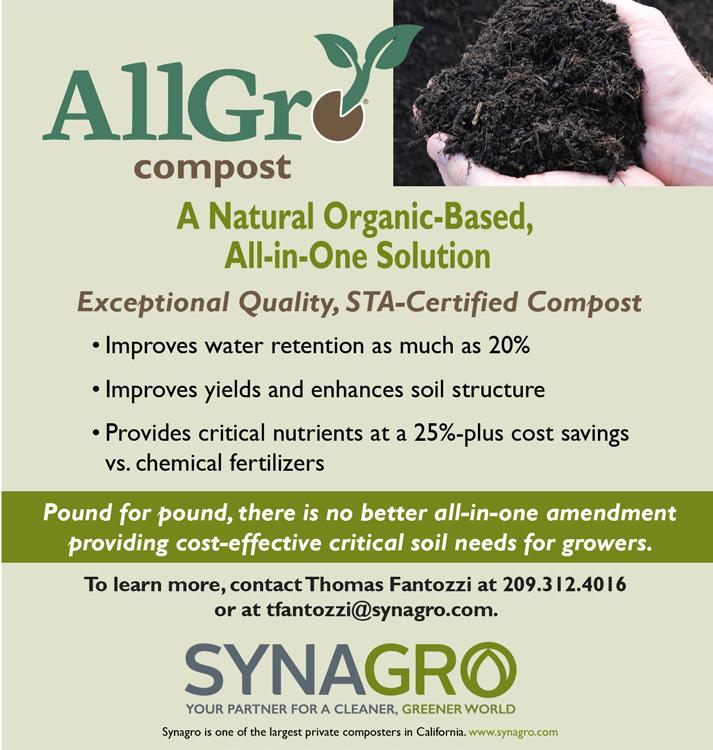
OSU trials were conducted with the minimum-horsepower tractor. A UC Weed Science publication noted an electric weed control trial using 5,000 to 12,000 volts on a 75 hp tractor was effective on both annual and perennial weeds.
In the trials, there were concerns with the effect of the electric charge on hazelnut trees. It is common for suckers to grow from the base of the tree, and as the applicators pass, the suckers could be zapped and the charge could be channeled to the tree. No significant issues with this have surfaced, Wirth said.
Two-foot and four-foot applicator heads were tested at OSU, but Wirth said applicator size can be customized to fit management needs. They have also been testing different heights and different speeds.
“At four miles per hour, we have been getting four to six weeks of bare ground with smaller weeds,” Wirth said.
Sosnoskie, formerly with UC Davis, is optimistic about the future of electric weed control. She said studies have been conducted to evaluate the impacts of both generator setting and tractor travel speed on weed control. These trials are also evaluating the safety of the technology with respect to soil microarthropods and soil microbes. She noted while data is still being collected, the preliminary work from 2022 saw no negative impacts. Trials are being done in apple orchards comparing this technique to cultivation.
Not Complete Solution
Moretti noted mowing and tillage are not complete solutions for weed control in all tree nut orchards due to management and harvest practices. Electric weed control, Wirth said, is not a complete replacement for tillage, mowing or herbicides.
“Electric weed control can be easily integrated into a weed management program targeting resistant weeds. I see it as a supplemental control measure,” Wirth said.
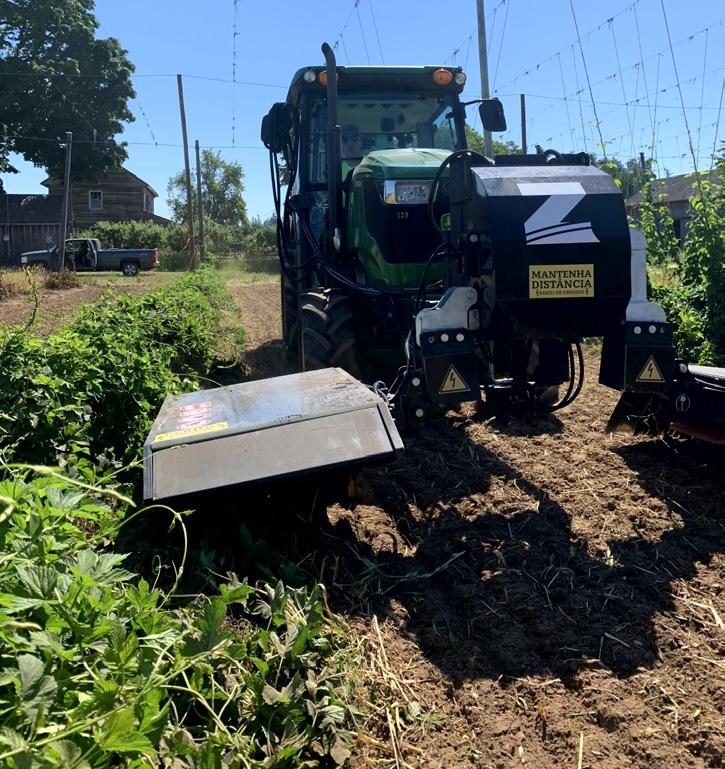
ContinuedfromPage6
8 West Coast Nut September 2023
Electric weed control is not a complete replacement for tillage, mowing or herbicides.
Herbicide-resistant weeds are a global problem, Moretti said, and tree nut species all have similar issues with weeds. They can reduce irrigation efficiency, harbor vertebrate pests and interfere with harvest of nuts that are placed on the ground to dry. Moretti’s USDA funded research focused on herbicide-resistant Italian ryegrass in hazelnut orchards, but he noted other tree nuts have similar issues with herbicide-resistant weeds. As of 2021, there are 13 weed species commonly found in almond orchards throughout the California Central Valley. Each of these weeds have had confirmed cases of herbicide-resistant biotypes in California.



Companies Invested in EWC
Moretti said there has been investment in electric weed control technology with at least three companies producing machinery. Zasso’s Electroherb weed control technology is based on a
mature, non-selective electrophysical mode of action. Its application uses dynamic adjustment of the high-voltage power being discharged to the targeted plants via a closed, uniform and directed electrical circuit. Morretti has been using this technology in his research.
UK-based Root Wave has RootWave Pro, a handheld weeder designed for spot weeding and treating invasive species. Each weed must be touched by the electrode for the electricity to flow; the natural resistance means the weed rapidly heats up killing both root and stem. To use this tool, a generator is required along with Respirex Dielectric boots that are mandatory for the operator.
Based in Germany, crop.zone also uses electrical current to shock weeds plants. The equipment mounts to tractors and consists of a front-mounted boom sprayer and a rear PTO-mounted generator and applicator boom. The front sprayer deposits a nitrogen- and
phosphate-free mineral solution called volt.fuel to enhance conductivity, while the rear boom trails surface contact applicator plates that expose the plants to a potential of between 2,000 to 5,000 volts. The volt.fuel liquid bridges leaf hairs and irregularities on leaf surfaces and softens the plant’s surface wax layer to increase electrical conductivity and lower power consumption.
Cost per acre for electric weed control, not involving cost of the machinery, is comparable to other orchard machinery operations. Fuel use is similar to the electric applicator. Machine maintenance at the OSU trials was minimal, Wirth said, with only the metal fingers in the applicator needing replacement.
Comments about this article? We want to hear from you. Feel free to email us at article@jcsmarketinginc.com
Ground Water Recharge? Periodic Flooding? Heavy or Light Soil? No Problem! Stan Schmidt - Butte City, CA 2nd Leaf Pecan Trees Flooded January - March, 2017 Stan Schmidt - Butte City, CA 2nd Leaf
Trees - Photo taken August 16, 2017 Karlene Hanf | 209.401.0346 | KarleneHanf@LinwoodNursery.com
Pecan
September 2023 www.wcngg.com 9
Three Crucial Decisions in Farm Business Succession Planning
 By GUIDO VAN DER HOEVEN | Extension Specialist/Senior Lecturer Emeritus, North Carolina State University
By GUIDO VAN DER HOEVEN | Extension Specialist/Senior Lecturer Emeritus, North Carolina State University

Taxes don’t destroy farms, families do,” is posited by Dr. Steve Isaacs, professor of agricultural economics at the University of Kentucky. A provocative statement to be sure, but with a great measure of truth. A quote by Benjamin Franklin may seem an explicit anthesis to Dr. Isaacs’ statement and is the theme of this article; the quote is, “If you fail to plan, you plan to fail”. This article expands on three decisions which owners of farm businesses must answer to create an estate or business succession plan that will defend against the potential destruction and failure often caused by family dynamics.
With the passage of the Tax Cuts and Jobs Act in December 2017, the estate tax exemption amount was doubled; for 2023, that amount is $12.9 million per individual ($25.6 million for married individuals). However, the exemption amount reverts to prior law and the exemption will be ~$7 million per individual starting Jan. 1, 2026. This change will increase media coverage regarding the importance of estate and succession planning for farm businesses.
Estate Planning
The Economic Research Service arm of the USDA has estimated that few
farms will be subject to estate tax. For those farm businesses which will be subject to the estate tax, it will be an issue which needs to be planned for and managed. Likewise, for those farms not subject to the estate tax, planning for succession is vitally important for the continuation of the farm business. While most farms will not be subjected to federal estate tax, there are still complex questions and issues which must be addressed by these farm owners as estate and succession plans are developed. Thus, all farms and farm businesses will benefit from succession and estate planning regardless of tax implications.
When reading the Wall Street Journal or the Investor’s Business Daily, for example, there are articles which prepare the market, finance companies, banks and others for changes in firm leadership and direction. Nobody likes surprises! Why shouldn’t closely held farm businesses follow this example as well as part of the planning process?
In my experience, the mechanics of estate and succession planning are ‘relatively’ easy. While the mechanism is elegant and user-friendly, the process and three major decisions of planning are unique and challenging for each estate/transition/succession. These unique answers will create a road map
for the future of each family farm business; thus, planning for transition should become a priority for the farm business.

Having a succession/transition plan in place provides landmarks to move the business forward even though there will be detours along the way. General Dwight Eisenhower stated, “...plans are useless but planning is indispensable.” This should not be taken as a discouragement, because once the plan is in play, new information will be discovered, so the plan must provide flexibility as it will not be perfect. As with much of farming, the goal is to do the best with the information available and to pivot and adapt according to new information when it’s available.
Business S Curve (or Business Life Cycle)
Figure 1 (see page 12) illustrates the Business ‘S’ Curve, or the Business Life Cycle. Growth is represented on the y-axis and time is on the x-axis. The curve begins on the lower left side of the graph, starting not at zero, but something above as human capital has value before business assets are acquired. The curve increases in scale over time and moves toward the upper right.
ContinuedonPage12
When it comes to estate succession planning, failing to plan is planning to fail.
10 West Coast Nut September 2023
Three key decisions for a farm transition plan are, Who Gets the Stuff, How Do They Get the Stuff, and When Do They Get the Stuff?








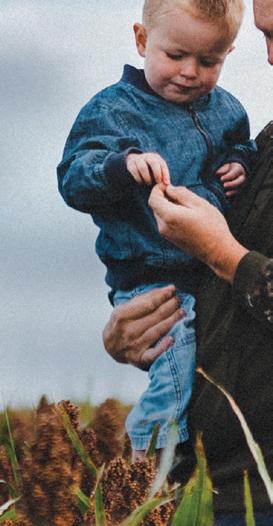

AgCredit is dedicated to serving the credit needs of young, beginning, and small producers. Along with unsurpassed expertise, we o er alternate financing and guarantee options for those who may not qualify under our normal lending requirements. We’re building the future of agriculture alongside those who want to be part of it. IT’S OUR MISSION. A Part of the Farm Credit System. Equal Opportunity Lender. FINANCING THE
GENERATION IS MORE THAN OUR BUSINESS. Your future grows here Visit agloan.com/young or scan the QR code to learn more.
American
NEXT
At some point in time, there is an “inflection point” where the curve has begun to decrease its growth; for this article, this inflection point represents new management or ownership coming into being. The point of inflection might represent death (or retirement) of the original owner and if there are successors. Are they indeed successful and follow the curve on a new upward path building upon the original owner’s foundation? Or, because of lack of planning or training, do the new owners follow the green dashed path of decline and the business fails?
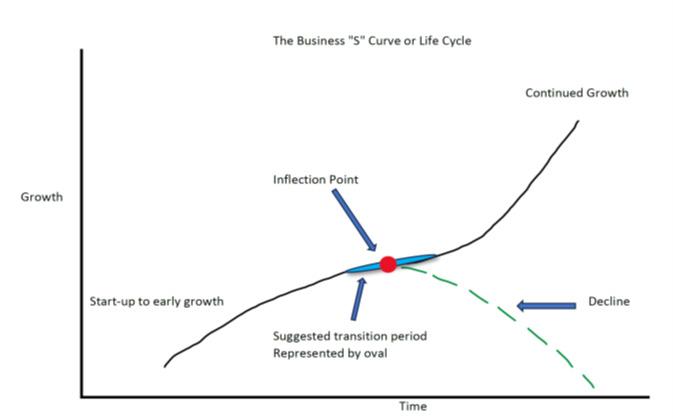
The light blue elongated oval represents a transition period which is planned and managed so that new ownership can indeed succeed and follow the curve to the upper right, continuing to grow the business. This elongated oval provides sufficient time to plan for and develop answers to the three decisions. However, the farm business must be of sufficient scale and profitability to provide the opportunity for successors to achieve the potential of continued growth and ultimately economic success.
Dr. David Kohl, emeritus professor of agricultural economics at Virginia Tech, argues farm firms must grow at least at an annual nominal rate of 5% to 6% per year (2% to 3% in real terms). Thus, the firm must be profitable to accomplish this task. If the farm is not profitable, then during the time of transition, which often means multiple families
are now deriving their living from the farm, cash flow and ability to meet those demands is not sustainable. The older generation and the succeeding generation may become adversaries, and hopes for succession are doomed and the farm business is destroyed.
The Three Difficult Decisions of Estate/Succession Planning

To navigate clear of failure, farm businesses must prioritize creating a flexible transition and succession plan that answers three complex decisions/questions. Additionally, it is vitally important once the plan is developed to clearly communicate that plan in some form and depth to all parties involved (family, employees, creditors and other professional service providers) to manage the element of surprise and lay the groundwork for continued farming operations into the future. Even if that communication is simply, ‘We have a plan and have done our best to be equitable.’
Barrett30 targets and eliminates nematodes leaving plants and soil unharmed. Growers benefit from controlling pests with our soft chemistry that is nonsystemic, uses minimal active ingredients and leaves zero trace of Barrett30 in the final product.

Say goodbye to nematode worries and hello to a successful harvest with Barrett30!



Within the planning process is the need to address and answer three difficult questions, which should be the priority of farms and ranches for succession to be accomplished.
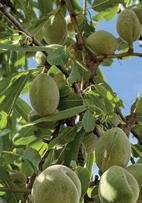
Decision 1: Who Gets the Stuff
(209)
The first decision that needs to be addressed is, ‘Who gets the ‘stuff?’’ Stuff here is a very technical term; it’s the business assets, liabilities, goodwill and anything else which is of value to the business. Typically, the “who” may be the on-farm heir. However, just because the on-farm heir has the same last name as the current business owner does not indicate their qualifications for succeeding as management. If they don’t have management skills to be successful, perhaps another route is better. Off-farm heirs might be considered if their skillset and passion can be utilized to continue to grow the business. Also, from a business sustainability perspective, long-term employees may be a possibility because without their contributions, the farm business may not be where it is today.
If the current owners look at the farm through a fiduciary lens, the answer to “who gets the stuff” may be a surprise.

Secure healthier crops with Barrett30
409-2558
barrett30.com chad@bpscience.com
Barrett30: The Ultimate Nematode Control Solution
ContinuedfromPage10
12 West Coast Nut September 2023
Figure 1. Business ‘S’ Curve, or the Business Life Cycle. Growth is represented on the y-axis and time is on the x-axis. The curve begins on the lower left side of the graph, starting not at zero, but something above as human capital has value before business assets are acquired.
Thus, the best model may be the farm as a “manager-managed” business with owners receiving a return on equity which may be shared with others.

Decision 2: How Do They Get the Stuff?
The second decision to be made is, ‘How do the recipients get the stuff?’ If the farm business is owned by a sole proprietor and the point of inflection in the graph represents his/her death, then the estate plan (if it exists) directs how the business assets transfer. Creating a transition plan means preparing for surprises that may arise during the reading of the will.
Long-term relationships may become damaged or strained, and relationship patterns may only become more pronounced. If a flexible plan is crafted, then land (possibly the most valuable asset) might be in a Limited Liability Company (LLC), which has explicit operating rules as well as a solid buy-sell mechanism to allow parties to exit without destroying the business. This form of business organization provides a mechanism to transfer property over time if so desired.
If the operating entity is held as a corporation, then successors acquire shares of stock through inheritance or gift. The business issue will be who has control over the operations of the business. Therefore, well-drafted language in the operating agreement(s) is required to provide the successor owner/manager(s) the flexibility to move the business forward or into a different direction. Rural areas continue to experience urban pressures, so entities with the objective of managing
and limiting liability become a natural choice for farm business owners. If these entities are chosen, how ownership and management is transitioned becomes a decision of extreme importance. Like LLCs, ownership and management of corporation transfer can be accomplished incrementally by gift or in total at a sentinel event such as death of the owner.
Decision 3: When Do They Get the Stuff?
The third decision which needs careful consideration is, ‘When do the recipients get the stuff?’ In the context of Figure 1, two options are presented. The first is the point of inflection represented by the red dot. This can be upon death or retirement of the business owner. This point can be very sudden, in the case of death; or it can be planned for in the case of retirement. Everything transfers at this point, and the complete changeover may not be the best of plans.


However, the elongated oval of transition represented by the blue area provides for a period where identified successors can be prepared for the eventual full management and ownership roles of the future. An identified successor could work as an employee with a known career path reporting
to grow into their future roles, and having personal investment provides incentive to develop the necessary skill set to continue the business and follow the upward trend of growth.
Presently, the window of higher estate exemption amounts may be closing as the law returns to a lower amount on Jan. 1, 2026, so estate/succession planning will become more important. The Business Life Cycle is applicable to all businesses regardless of scale (who remembers Enron?). The planning process needs to address the difficult questions facing owners of closely held farm/ranch businesses: Who gets the stuff, how will they get the stuff and when will they get the stuff? Planning for a period to identify and develop answers to these questions as represented by the blue elongated oval of transition in Figure 1 is of prime importance to transfer the business to the next generation. Putting together a team of competent advisors to address these questions is the responsibility and obligation of farm/rancher owners in creating their plan for the future success of their business. A flexible and well-organized transition plan will act as a well-drawn road map, leading farm businesses of all sizes through inheritance and succession transitions toward
STEEL BUILDINGS



HILBERSINC.COM 530.673.2947 770 N. WALTON AVE SUITE 100 YUBA CITY, CA 95993 Hilbers Inc.
is the
you can
partnering with Butler
team
trust.
operating as 100% employee-owned.
build structures and Relationships to last.
Whether it’s a design-build project, renovating and/or expanding an existing building, Hilbers Inc. and Butler have the expertise to see you through to the completion of your pre-engineered metal building project! Proudly
We
September 2023 www.wcngg.com 13
Sample Soil First Before Applying Postharvest Nutrients in
By CECILIA PARSONS | Associate Editor
Orchards that became flooded in the winter and spring may need a soil analysis before implementing a new nutrition plan to address losses (all photos by C. Parsons.)
Nitrogen, potassium, boron and zinc are the four key nutrients necessary for pistachio production, but research has shown they are not always needed postharvest. Douglas Amaral, UCCE orchard advisor in Kings and Tulare counties, stressed that monitoring the levels of these nutrients in an orchard should be done annually to determine orchard needs for optimum production.
Most nutrient applications take place in the spring, when root uptake is highest, but postharvest nutrition needs should not be overlooked. Amaral noted weather, flooding and pistachio variety could direct some changes or alterations in a grower’s nutrient management plan to include postharvest nutrient application.
“Flooding that occurred this year is a concern, how it has affected nutrient availability, and it is drawing grower attention,” Amaral said. Orchards that became flooded in the winter and spring may need a soil analysis before implementing a new nutrition plan to addresses losses. And, while some important nutrients may have been flushed from the root zone, others may have increased levels in the soil due to sediment deposition, Amaral said. His current research in pistachio nutrition is also looking at possible variation in nutrient application timing and use in the varieties Golden Hills and Lost Hills, two earlier blooming pistachio varieties that are being planted in higher numbers now than the standard Kerman variety.
Amaral said that data on the Golden Hills and Lost Hills nutrition studies should be available next year.
“So far, it appears that demand is similar to that of Kerman, but no conclusions yet.” Amaral said he is conducting research on all pistachio nutrients to determine if there is any change in uptake throughout the season.
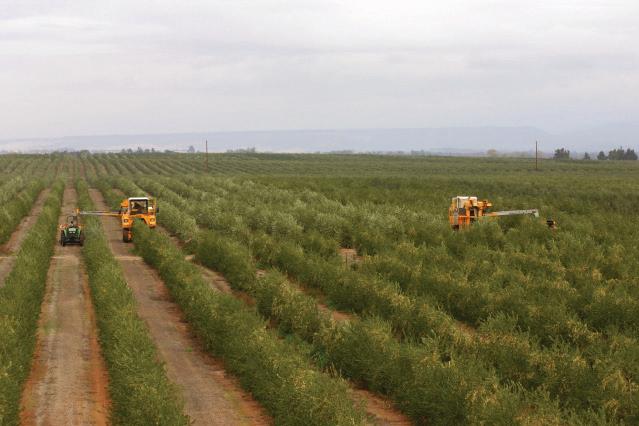
There are two main nutrient concerns in postharvest pistachio production: nitrogen and potassium. Unless there was an insufficient amount of nitrogen applied in the spring and summer or yields were overestimated, there is
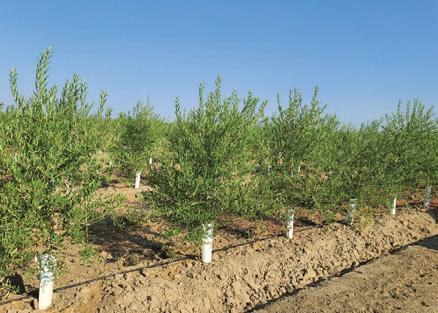
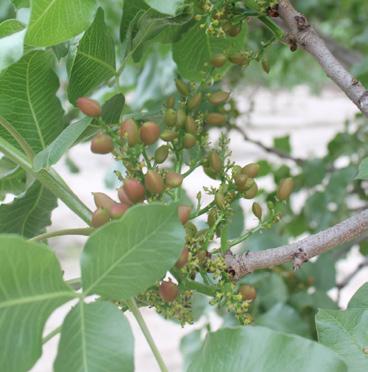
Pistachios
Cliff Beumel 530-531-7086 cbeumel@agromillora.com Main Office 530-846-0404 www.agromillora.com SUPER HIGH DENSITY OLIVES FOR OIL Your Best Orchard Crop for the Future! California Nursery Gridley, CA -OLIVE OIL PRICES AT ALL TIME HIGH -FASTER ROI -GROWN, MILLED AND SOLD IN US -HIGHEST PROFIT IN ORCHARD CROPS -100% MECHANIZED FROM THE MOMENT OF PLANTING OLIVES REQUIRE THE WATER OF ALMONDS AND ¼ THE NITROGEN TO PRODUCE A FULL CROP 14 West Coast Nut September 2023
no need for postharvest nitrogen application. Nitrogen uptake is based on yields. Research has shown for every 28 pounds of pistachios harvested, 1,000 pounds of nitrogen is taken from the orchard.
Nitrogen
In an issue of San Joaquin Valley Trees and Vines, a UC publication, Amaral noted nitrogen, an essential for many plant processes, must be managed carefully to avoid not only losses to run off, but loss of efficiency. Maximizing yields and minimizing loss to environment makes matching N demand by tree to N supply critical for preventing economic loss.
Amaral wrote leaf sampling alone does not provide a clear picture of nitrogen needs. In January, an estimate of expected orchard yield based on historic trends and the previous year’s yield should be done. The estimate should also take into account number of chill portions thus far in the season and weather patterns. An accounting of all
N sources in the orchard should be included along with leaf sample analysis. Nitrogen application strategy should reflect the leaf, yield and soil estimates. A spring leaf sample can determine the N concentration in the leaves can be a measure of the nutrient management plan and to see if there are deficiencies or toxicities. Amaral noted that July leaf samples are too late in the season to adjust fertilization applications. He said a validated model for predicting July N levels from early season leaf samples can predict summer values. An example is a 3% N leaf sample taken 40 days after full bloom would be 2.6% in July, which is sufficient for kernel filling.
Trials done by UCCE Area Orchard Systems Advisor Katherine Jarvis Shean showed there is little to no nitrogen uptake after harvest by pistachio trees, but after an ‘on’ year, there is a recommendation that 20% of the annual nitrogen budget be applied when pistachio nuts reach maturity or shortly after harvest.
Amaral noted sufficient nitrogen is
needed for tree growth and yield, but overapplication can negatively affect uptake of other nutrients. It may also result in excessive vegetative growth rather than production.
Potassium
Potassium is commonly banded in orchards in the fall, Amaral said, and it should be done no later than October. November applications are acceptable if done before a rain. This nutrient loosely binds to clay and soil organic matter, protecting the nutrient from leaching over the winter. Typical products used are potassium sulfate and potassium chloride. Bands should be made in the wetted zone in the tree row as any that fall outside will be inaccessible to the trees. This nutrient may also be applied via fertigation.
Solubility is not an issue in fall-banded applications, but it may be a consideration in fertigation. The lower the solubility of a K fertilizer, the more

ContinuedonPage16 September 2023 www.wcngg.com 15
water is needed to dissolve it.
Zinc
UCCE Farm Advisor Phoebe Gordon wrote in San Joaquin Valley Trees and Vines that the micronutrient zinc is commonly deficient in Central Valley soils due to high pH. Foliar applications are typically done in pistachios in the spring. Soil applications are not. Reduced yield is a common sign of zinc deficiency.
Symptoms in pistachio trees include interveinal chlorosis in addition to smaller leaves and extremely short internodes resulting in a rosetting effect. Gordon notes the most practical solution to a zinc deficiency is a foliar application during early spring flush.
Foliar applications of boron and zinc in pistachios are commonly done in the spring, but Amaral noted in the past, a zinc application was done in the valley mainly for defoliation. That practice is no longer recommended.
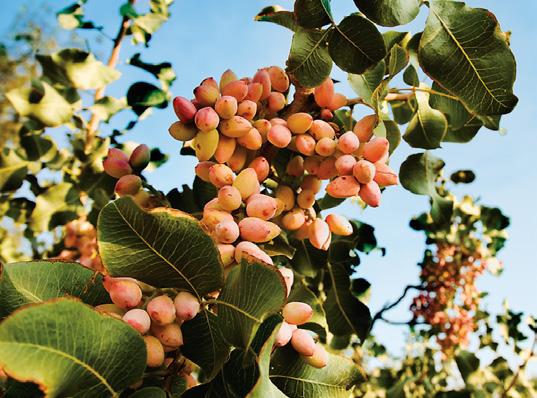

BUY IT, GROW IT, SELL IT. GUARANTEED.
ORDER
It’s simple. Wonderful Nurseries works closely with our sister company, Wonderful Pistachios to offer Pistachio Purchase Agreements to clients planting our trees. Whether you are purchasing our Wonderful Pistachio Rootstock™ (WPR) or standard UCB-1 rootstock from seed, we have a home for your product. Contact us today to place your order and grow your rootstock into guaranteed sales!
Boron
Soil-applied boron, Amaral noted, is not taken up by the trees in the fall. It has been noted in research that pistachios are boron-hungry. Gordon notes that leaf monitoring is advised to evaluate for deficiency or toxicity. Deficiency symptoms are cupped and deformed leaves, though they retain their green color. Research done by Louise Ferguson and Patrick H. Brown at UC Davis showed the best time for foliar application of boron is from the late dormant to early bud stages. Soil applications of boron are not as effective as foliar applications for supplying sufficient boron for flowering.
Tools
Amaral recommended the following tools to help pistachio growers improve their fertilization plans. The Nitrogen and Potassium Prediction Model for Pistachio provides information on leaf sampling techniques and in-season N applications. The California Fertilization Guidelines for Pistachio has recommendations for nitrogen, phosphorus and potassium, including general deficiency symptoms, soil testing and soil and foliar applications. The Pistachio Prediction Model uses nutrient analysis of spring leaf samples to predict late summer nutrient concentrations of nitrogen and potassium K.
Amaral noted these tools and guidelines have been developed specifically for the Kerman variety but are also considered useful for other pistachio varieties.
Comments about this article? We want to hear from you. Feel free to email us at article@jcsmarketinginc.com
ContinuedfromPage15
New prediction models can help integrate leaf sampling into in-season nutrient applications.
PISTACHIO TREES FROM WONDERFUL NURSERIES AND YOU’LL HAVE A GUARANTEED HOME FOR YOUR CROP
WonderfulNurseries.com 661.758.4777 27920 McCombs Road, Wasco, California 93280 © 2023 Wonderful Nurseries LLC. All rights reserved. WONDERFUL, WONDERFUL NURSERIES and the accompanying logos are trademarks of Wonderful Nurseries LLC or its affiliates. The Wonderful Pistachio RootstockTM Trees are the subject of U.S. Plant Patent Nos. PP26915, PP26916, PP27318, PP27319 and PP27436. SERVING YOUR VINE, ALMOND AND PISTACHIO TREE NEEDS 16 West Coast Nut September 2023
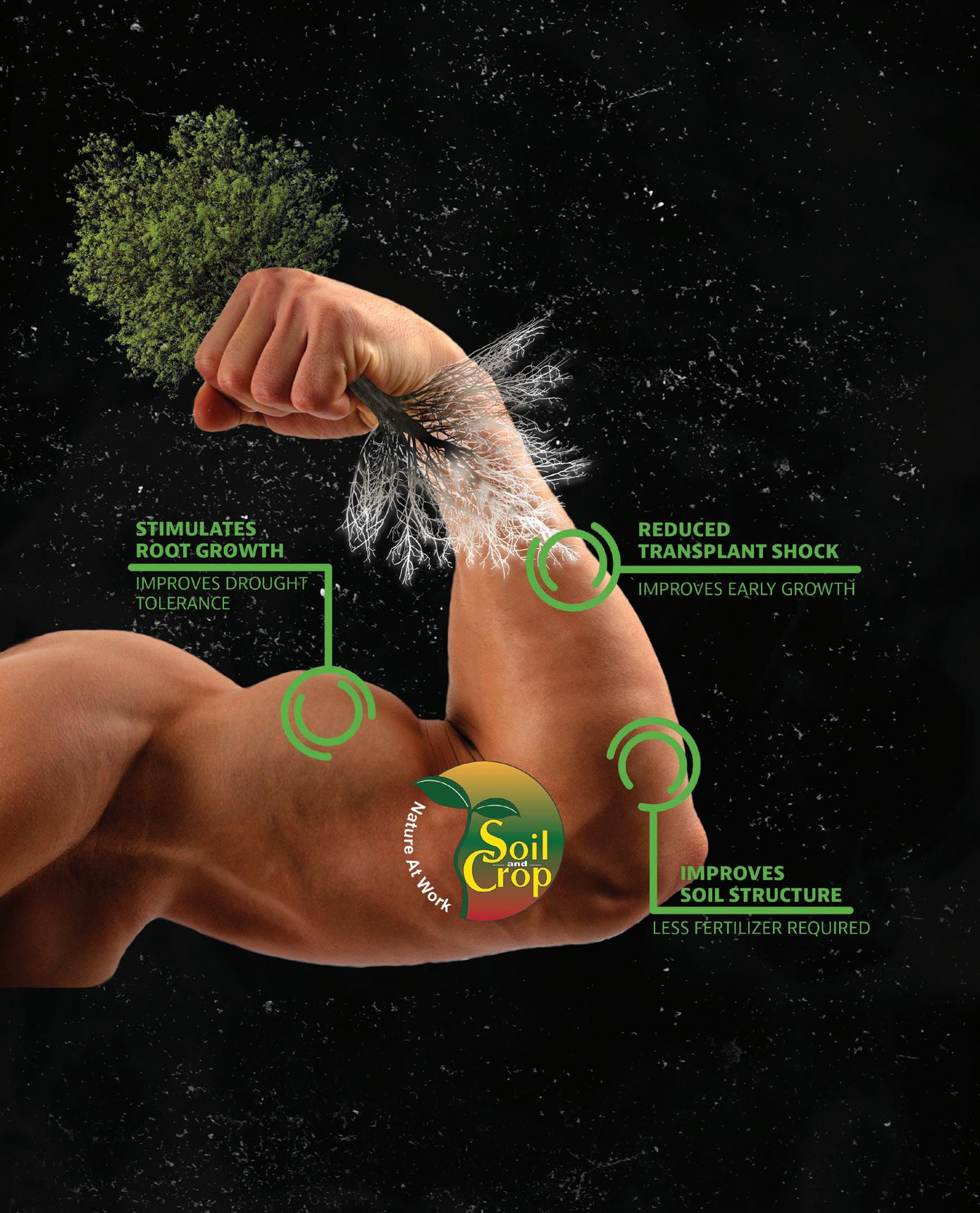

New EU Import Thresholds Prompt Action on Ochratoxin A Successful Pistachio Export Aflatoxin Reporting (PEAR) program is expanded to include OTA mycotoxin.
By VICKY BOYD | Contributing Writer
By
Prompted by new European Union (EU) import thresholds for a food contaminant, the pistachio industry is funding research to gain a better understanding of the causal fungal agents and potential management.
Now in its third year, the work led by UC Davis Plant Pathologist Themis Michailides and his post-doctoral fellow, Pummi Singh, has found a few Aspergillus fungal isolates collected from state orchards produced ochratoxin A above EU thresholds in laboratory tests. But the vast majority did not.
In addition, he said an atoxigenic Aspergillus flavus strain used to manage aflatoxin-producing strains of the same fungus appears effective in lab studies against species responsible for ochratoxin A, or OTA as it is abbreviated.
The pistachio industry saw a need to fund this type of research after the EU proposed OTA limits in 2020 and implemented them on January 1, said California Pistachio Research Board Manager Bob Klein.
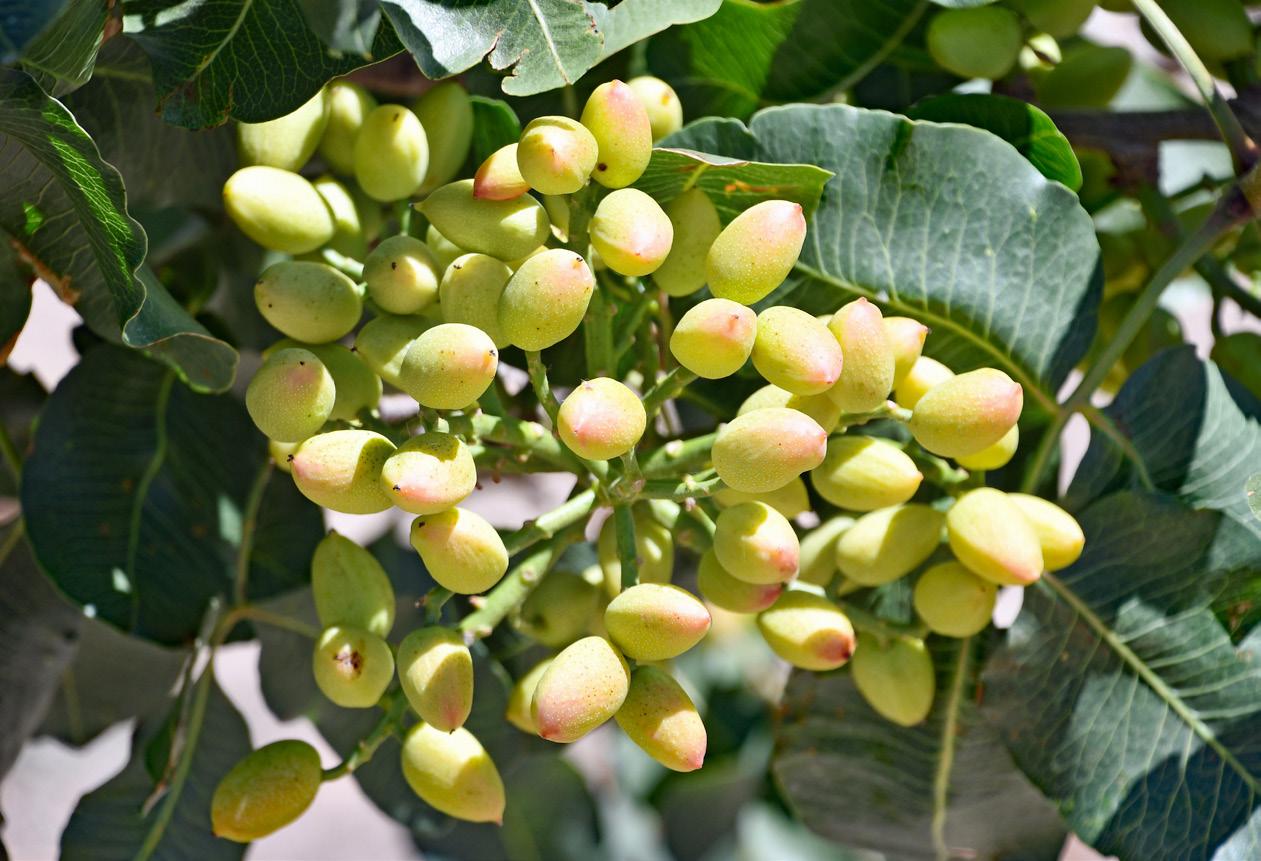
In addition to Michailides’ research, the industry has also done a small amount of work looking at OTA’s prevalence in nuts. Grower samples collected from the 2020 crop found OTA and aflatoxin levels and distribution to be essentially the same, Klein said. 2020 was considered a low aflatoxin year.
“During processing, OTA and aflatoxin showed up in the same kind of nuts, insect damaged and stained,” he said.
Samples from the 2022 crop found OTA levels about half
 The pistachio industry is funding research to gain a better understanding of the causal fungal agents and potential management of ochratoxin A (photo by V. Boyd.)
The pistachio industry is funding research to gain a better understanding of the causal fungal agents and potential management of ochratoxin A (photo by V. Boyd.)
18 West Coast Nut September 2023
those of aflatoxin.
“How much it will vary from year to year, we don’t know,” Klein said.

In response to EU aflatoxin limits, the Administrative Committee for Pistachios implemented the Pistachio Export Aflatoxin Reporting (PEAR) program in 2018 as a formal control program, Klein said. It tests each 40,000-pound load of U.S.-grown pistachios destined for the EU for aflatoxin levels. With the EU adding OTA thresholds, the PEAR program will also screen for that mycotoxin.

Calling the PEAR program a success for aflatoxin screening, he said it has further lowered EU rejections levels.

“It’s been going for the last several years, and we hardly see rejects out of the EU,” he said. “It happens rarely enough that it’s not a huge concern. But there are still enough positives that it gets our attention really quickly.”
What is Ochratoxin A?
The EU updated its regulations for maximum OTA levels in food based on 2020 recommendations from its European Food Safety Authority. Effective
Jan. 1, the new thresholds include 5 parts per billion for pistachios marketed directly to consumers or used as food ingredients. The threshold for pistachios subject to sorting or other physical treatment before being marketed is 10 ppb. The higher threshold reflects additional sorting’s potential to reduce aflatoxins and perhaps OTA levels.
OTA is not a newcomer to the food industry either, with scientists first isolating and characterizing it in 1965. Since then, it has been found as a natural contaminant of moldy food and feed.
OTA also is classified as a mycotoxin, the same group of compounds to which aflatoxin belongs. The International Agency for Research on Center classified OTA as a possible human carcinogen in 1993.

Several species in the genera Aspergillus and Penicillium such as Penicillium verrucosu are known to produce OTA in certain crops.
Many of the Aspergillus species are poorly understood, complicating research into their potential to contaminate foods with OTA. Even within an individual species, some strains are
atoxigenic, meaning they don’t produce toxins, while other strains do.
In North America, most of the studies of ochratoxins in crops have focused on P. verrucosum contamination of cereals in cold climates.



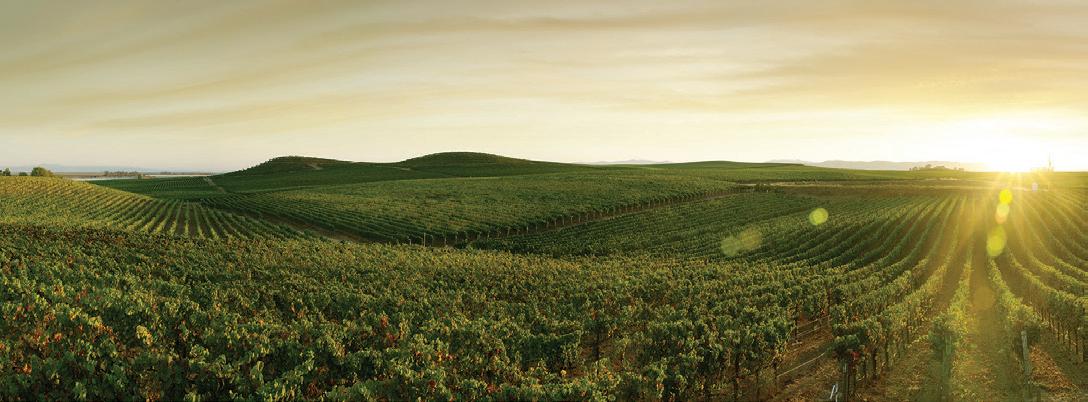
Low OTA Prevalence
Since California nut and fig crops have never been reported to contain the high OTA levels found in wheat and other crops, Michailides said they hypothesized that atoxigenic strains dominate ochratoxin-producing species.
As part of the initial two-year study, Singh and Michailides collected samples from tree nut and fig orchards in California as well as from packaged tree nuts purchased in the state. In the nut orchards, the samples were from fruit, leaves, soil or air.

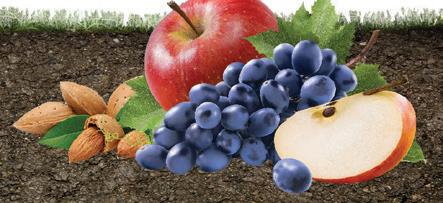
He said they focused on figs and pistachios because they have received EU alerts for those crops but not for almonds.
They isolated 72 fungi from the Aspergillus ochraceus group and Aspergillus alliaceus, grew them on special nutri-

400 S 200 E, EMERY, UT 84522 | (435) 286-2222 | (800) 846-2817 CALL ERNIE AT (661) 304-2676 APPLY HUMATE WITH YOUR POST-HARVEST SOIL AMENDMENTS
ContinuedonPage20 September 2023 www.wcngg.com 19
ent-rich media for 10 days and tested for OTA production.
Among the isolates, common. No field isolates of either species produced OTA levels above the 1 ppb detection level. But all the isolates produced OTA, with levels up to 30 ppb.
Nevertheless, more common to predict a very low probability for OTA contamination. Another fungal group in North America, been studied about whether it could potentially produce OTA.
But Michailides said other questions remain. They found A. ochraceus and tree litter at about the same frequency as fungi responsible for aflatoxin. But he found it surprising that none of the A. ochraceus above the 1 ppb detection level. After all, OTA had origi nally been isolated from the two fungal species. But perhaps populations of those two fungi found in orchards comprised mostly atoxigenic strains.
Based on the initial research, he said further work should focus on A. alliaceus
Learning from Aflatoxin Experiences
Fortunately, Michailides said, recent research has shown A. alliaceus is related to they remain hopeful that information about aflatoxin con
tamination may be helpful in predicting and preventing OTA

Among the aflatoxin management tools are reducing tree strains to crowd out show they may also be useful in reducing fungi that produce
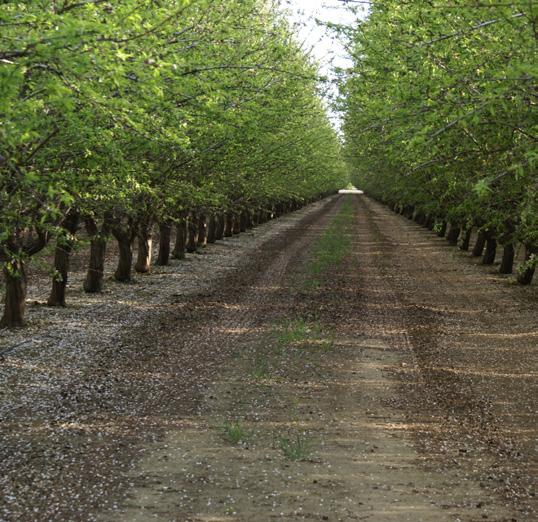
Helping Farmers Grow NATURALLY Since 1974

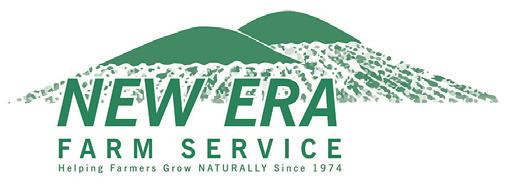


O ce: 559-686-3833 Fax: 5 59-686-1453 2904 E. Oakdale Ave. | Tulare, CA 93274 newerafarmservice .com
ContinuedfromPage19
20 West Coast Nut September 2023
Effective Jan. 1, the new ochratoxin A thresholds include 5 parts per billion for pistachios marketed directly to consumers or used as food ingredients. The threshold for pistachios subject to sorting or other physical treatment before being marketed is 10 ppb (photo by M. Katz.)
Currently, Aspergillus flavus AF36 Prevail and Afla-Guard, strains that do not produce aflatoxin, are registered for use in pistachios and almonds. The former is produced by the Arizona Cotton Research and Protection Council, a non-profit state agency originally formed to develop the product for cotton growers. The latter is from Syngenta.
Sorghum kernels that have been sterilized so they won’t germinate are coated with the beneficial fungus. The grain serves as a food source and carrier. In laboratory studies, both products reduced OTA similarly with an over 80% reduction when pistachio kernels were co-inoculated with the OTA-producing Aspergillus ochraceous and each of the registered atoxigenic strains.
Applying AF36 Prevail or Afla-Guard changes the fungal composition in the orchard, shifting the population as the safe atoxigenic strains displace potential aflatoxin producers.
Along those lines, Michailides just began studies that examine whether
navel orangeworm infestations are tied to OTA as they are with aflatoxin in pistachios.
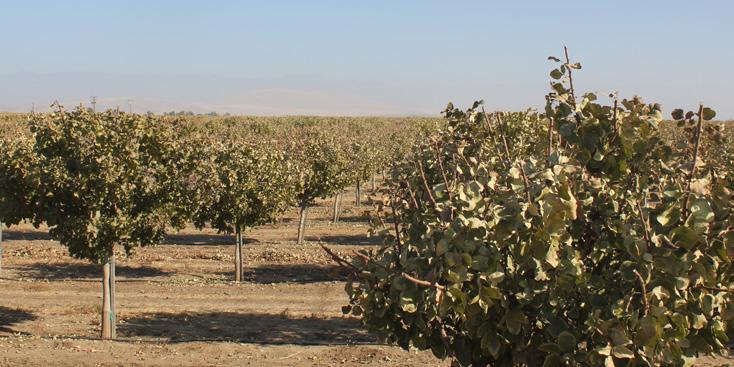
Early splits, where both the shell and hull split before the bulk of the crop, have been the bane of pest and mold management. By themselves, they can increase aflatoxin contamination by the NOW infestation and creating fungal entry ways to the kernel.
The abnormal nuts attract female NOW, which lay eggs in the kernels and increase overall insect damage. The feeding sites also serve as conduits for
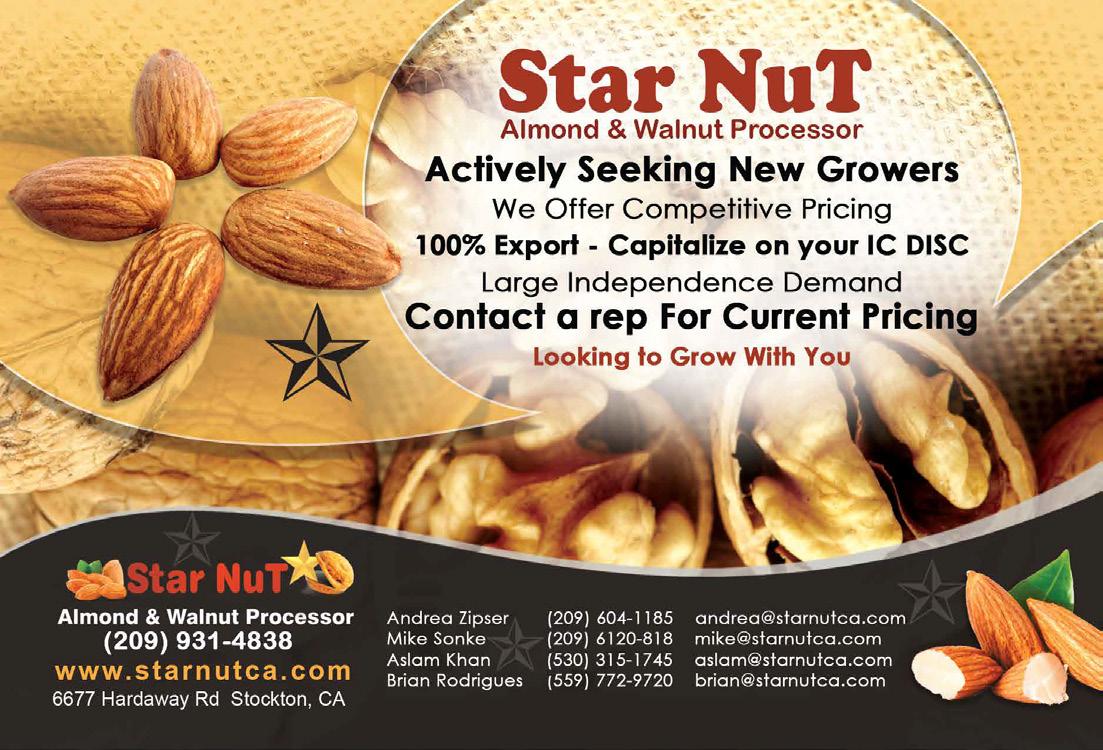
mold, including the species responsible for aflatoxin and most likely OTA. In addition, NOW larvae have been found to carry A. flavus spores into the kernel.
“(Early splits) become the Achilles heel of early infestations by NOW and also aflatoxin, and we suspect for ochratoxin, but we haven’t shown that,” Michailides said.
Comments about this article? We want to hear from you. Feel free to email us at article@jcsmarketinginc.com
September 2023 www.wcngg.com 21
Among the aflatoxin management tools are reducing tree stress, proper irrigation, winter sanitation, properly timed NOW treatments and timely harvests (photo by C. Parsons.)
Grower Profile: Adam Orandi
Bringing Generations of History Farming Pistachios in Iran to His Family Farming Operation in California
 By LORI FAIRCHILD | Contributing Writer
By LORI FAIRCHILD | Contributing Writer

Sometimes your true calling shows up when you least expect it.
Growing up in the snowy winters of Minnesota, it rarely occurred to Adam Orandi that California farming was in his future.
Orandi lived in the northern town of Fergus Falls, an area full of families who farmed various crops and livestock. His parents, however, were in medical professions. His mother was a nursing student, his father a pathologist who was the town’s coroner. But their family had a rich history of farming pistachios in Iran.
“I’m technically a sixth- or seventh-generation pistachio farmer,” Orandi said.
It wasn’t until he was a teenager that he started working the soil and learning pistachio tree nut farming and orchard management on the farm his father bought in Terra Bella, Calif. in 1971. Orandi’s summers were spent in the orchards, and he knew the nut industry was the place for him.
After years of learning the business firsthand from the ground up in this capacity, Orandi purchased and expanded his father’s original pistachio processing facility Orandi Ranch. Embarking on his solo venture, ARO Pistachios, today he oversees more than 1,000 acres of pistachio orchards across the San Joaquin Valley as CEO of ARO Pistachios and AOK Farming. The company is a family endeavor with his wife Pamela Orandi filling the role of communications and events, applying her background in publishing.
One of the things they appreciate most are the relationships they have made through Orandi’s service to the industry.
“That’s been another great part of being involved with this community. We’ve met so many fun, caring and really genuine people,” Pamela said.
Both she and her husband completed the LeadOn APG pistachio program early on, and she felt fully welcomed by generations of pistachio farmers.
Orandi served two terms on the board of directors for the American Pistachio Growers (APG) and as chair of the membership committee. Additionally, he served terms as vice president then president of the California Pistachio Export Council.
Whether he’s working in the orchard or serving on a committee, Orandi is cautiously optimistic about the future of the California pistachio industry and was happy to share his thoughts with West Coast Nut about both the past and future of the industry.
Q. Tell us a little bit about your family’s history with pistachios.
My dad, Mehdi Orandi, grew up on a pistachio farm in Rafsanjan, Iran, which is considered the pistachio capital of that country. He came to the U.S. in the 1950s to become a physician, and that’s how we ended up in Minnesota.
ContinuedonPage24
Adam Orandi (right), CEO of ARO Pistachios, stands with his father, Dr. Mehdi Orandi, in a pistachio orchard during harvest (photo courtesy P. Orandi.)
22 West Coast Nut September 2023
Growing pistachios is a family affair for Adam and Pamela Orandi and their sons (photo courtesy P. Orandi.)

He read that people were experimenting with pistachios in the U.S. in the late ‘60s and decided to drive out to California and look for himself.
In the early ‘70s, he planted his first 100-plus acres of trees before there was really a pistachio industry that we see today. I think the early pistachio commercial crop in the U.S. was ’76 or ’77, and so we were certainly part of the first development of California pistachios as an industry.
Q. How did you get involved in the industry?
I never knew I was going to become
a farmer. I naturally thought I was going to be a doctor. But as life had it, I got into it, and I love it.
After college in 1993, I worked fulltime with my dad. He was my mentor and is very knowledgeable, and we spent a lot of time together side-by-side. On the farm, he had built a small pistachio processing facility, so I dove into that. That became more of my focus, the food manufacturing side.
I started my own company, ARO Pistachios, developing my father’s original processing facility and expanding it exponentially. In its first nine years, it increased from 1 million pounds volume to over 20 million pounds.
In 2020, out of the blue, I was approached to sell my facility. I loved what I was doing on the food-manufacturing side. But with expansion and managing something this size comes long hours. The buyer needed a home for his crop, my wife and I were raising our young sons, and I love being a dad, so we decided this was an opportunity. ARO Pistachios had several hundred employees at the time, and it was a very stressful job.
I decided I really would rather slow down. Another consideration was that I never could really get into the farming side of it as much as I’d liked because it was so expensive. The sale of the plant allowed me to invest in acreage. Now I’m fully on the farming side of it. I love it. It’s a lot less stressful. And it’s a legacy for my family.
Q. How have your farming practices evolved in recent years?
Water is imperative. We use technology to target the appropriate amount of water and make sure we are maximizing our yields using the correct amount of water, the correct amount of nutrition, the correct amount of pest control. The more precise we can be with that, the better off it is for everybody. The better off financially, the better off it is for the land, the safer it is for the consumer, the safer it is for the employees. We use instruments such as soil sensors that measure the water in the ground and monitor, verifying the appropriate amount of water is in there.
We use a lot of tech that is available to the industry. We use weather
stations to track chilling hours, track temperatures, track all sorts of variables that go into our decision making for what, where, and when we apply farming practices.
Q. How do you feel about the future of the pistachio industry in California and the challenges it faces?

I am hopeful for all tree nuts in California: almonds, walnuts, pistachios. They all sail on the same ship with the challenges that they’re facing. They’re all very capital-intensive.
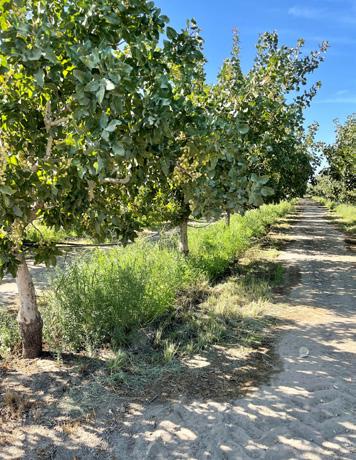
Some of the biggest challenges would be the regulation that’s coming in with food safety. It’s expensive and there are, of course, important considerations as with most industries. All of this regulation translates to more dollars for important areas such as food safety, air pollution, groundwater. All these things now add layers to the whole program, which directly and indirectly correlate to greater expense.
Land is not cheap in California. Water is a very serious issue whether you have groundwater or surface water. Then with your water portfolio, how are you addressing SGMA (Sustainable Groundwater Management Act)? 2040 is ground zero. You better have it figured out ASAP. Unfortunately, there are some growers who have not modernized their farming practices and are now faced with the burden of additional expenses. Sadly, a lot of farmers are in that boat where they don’t really understand and are getting some large invoices.
Q. What is your approach to SGMA?
I have a dozen or so farms, different locations, and each farm has groundwater, which is made up of your native yield and all the different factors that go into what you’re allowed to take out of the ground in that location. Then most of my orchards also have surface water, some sort of contract with the district, and it really kind of boils down to an account. In each account, you have this much water each year, you use this much water this year. What are you left with?
Now, that’s become a full-time job for my company, really managing the
ContinuedfromPage22
Adam Orandi uses winter wheat as a cover crop in his company’s certified organic pistachio orchard (photo courtesy ARO Pistachio.)
24 West Coast Nut September 2023
Harvest at ARO Pistachio (photo courtesy ARO Pistachio.)
water demand for each orchard, making sure that we have a plan for each property. Reputable, knowledgeable consultants are a resource to advise on water board meetings, and together we collectively strategize. This is what every farmer in California is going to have to do. It’s not coming. It’s here right now.
I think there’s going to be some settling in the next few years. It’s been a very successful industry and people have been successful turning a profit, which has attracted a lot of attention, but SGMA really changed all that.
Q. What are the biggest assets of the pistachio industry?
In the U.S., one of the things we hang our hat on is food safety. We sell most of our crop overseas, and everyone is concerned with food safety, some more than others, but I think that gives us a competitive advantage in all markets.
Of course, with regulation comes cost, as I mentioned. On the global stage, people look for California pistachios because they know they can count on a certain amount of testing and protocol and production. That’s a big advantage for us.
Q. What are your thoughts on marketing pistachios?
Pistachios take six to eight years to come into production. There are still a lot of trees in the ground that have been planted in the last eight years that are coming up. This translates to a huge increase in supply, which means we must be very strong in our marketing.

What I don’t want to see is commodity based. We want to get the most return to the growers because it’s super costly to get into pistachios and to farm it year after year without a penny back. You’re going deep into the red before you start to turn that around.
It’s vital to make sure we are marketing, that we are getting pistachios to people who have not yet eaten a pistachio.
Pistachio nuts are a complete protein and such a beneficial food. We really need to focus on a combined effort as an industry to market our crop.
Q. How do you give back to the community, both in ag and in the community where you’re based?
Giving back to the community, I think, as a farmer begins with land stewardship. We need to make sure we’re not exploiting the ground and that we’re farming in the best, most responsible manner, not only for the soil, but for the area around us.
I believe in giving back and paying a fair wage. Helping in the community with youth groups, for example.
Q. What advice would you give to a young person getting into farming today?
The saying is true: if you love it, it won’t feel like work. There is a ton of opportunity for young people today to get into either the farming side of it or the farm-related industry. It’s a lifestyle. And if you want it, put in the effort, you will love it.
Comments about this article? We want to hear from you. Feel free to email us at article@jcsmarketinginc.com

September 2023 www.wcngg.com 25
Adam Orandi, a sixth-generation pistachio farmer, inspects his pistachio orchards (photo courtesy P. Orandi.)
The Way Forward for Almonds Industry
veteran Keith Rigg of Minturn
Nut
Co. on prices, tariffs and where he sees the industry
headed
By CATHERINE MERLO | Contributing Writer

Satellite imagery may capture LeGrand, Calif. as a small, monochromatic square in a patchwork of green and gold farmland.
But what high-tech eyes can’t see is this Central Valley town of 1,600 people is home to one of the largest almond businesses in the state.
Located 14 miles southeast of Merced, Minturn Nut Company handles more than 100 million pounds of almonds a year. Its facility spans more than 400,000 square feet under roof, with another 100,000 square feet covered by overhang.
The company processes and markets brown-skin and in-shell almonds for roughly 400 growers, sending their product to foreign customers that include China, India and Europe. A third of its volume is sold to U.S. buyers. Minturn Nut employs up to 160 employees for most of the year.
At the center of all this is Keith Rigg, Minturn Nut’s CEO since 2007. An almond industry veteran, he began his career in 1980 as a field representative for Blue Diamond Growers. In 1992, Rigg went to work as procurement manager for Chica-

go-based John B. Sanfilippo & Sons, a large, diversified nut company. Seven years later, he joined Minturn Nut. Since 2012, Rigg has also been its managing partner. Here, he shares his thoughts on the almond price outlook, India’s tariffs and his opposition to the socially conscious demands of ESG policies.
Q. What’s your outlook for almond prices over the next
year or two?
The last time we were met with these kinds of challenges was in the early 1980s, when we had similar issues: a stronger dollar, higher interest rates, inflation and so forth. But if you just look back to last November, December and January, our industry was breaking sales and shipping records per month. Then in February, when we started receiving all the rain and cold weather during bloom, we as an industry intentionally pulled off the market. Having the luxury of the rear-view mirror, that’s probably something we shouldn’t have done quite as severely as we did because it did stop our momentum.
Once we are again comfortable with the supply picture, our industry can get back into the mode where we accept the market for what it is, not that we’re going to lay down and accept any low price but have a clear focus on trying to get out from under the weight of our inventory. That truly needs to be our focus. What was promising in looking back at those three months when we were breaking records, most of the increased demand was coming from our emerging markets. One can say, ‘Yes, they’re price-sensitive and prices were cheap,’ but I’m encouraged we can get those markets rolling again. Our goal is to build inelastic demand in those newer markets.
Q. India recently removed its retaliatory tariffs on U.S. almonds. What are your thoughts on that? And how long do you think it will take California to regain its market share there?
It’s not regaining it; it’s building it further. Even during the last few years when we had the retaliatory tariffs in place, we were still able to grow the market. Any tariff sav-
View from the
Top
A Way Forward for
Nut Industry 26 West Coast Nut September 2023
Minturn Nut’s CEO since 2007, Keith Rigg has more than four decades in the almond industry (all photos by C. Merlo.)
the
ings is good. We’ll take all we can. It amounts to about 3.3 cents a pound on in-shell sales. It’s about 11 cents a pound in savings to California or to India, depending on how you look at it, on the meat delivery.

Q. Well, that’s good, isn’t it?
Yes, every bit counts. We haven’t seen an administration willing to go to bat for trade, period. So, this is welcoming to our industry and encouraging to any other industries trying to negotiate on tariffs. On the other hand, we need to really fight for our industry to get our meat tariff brought down to inshell parity. The tariff on meats is three times that of in-shell. Right now, we’re at a huge disadvantage to Australia. Their tariff is half of what our in-shell is. We’ve got both an arm and a leg tied behind our back trying to compete against that.
All the Indian buyers I deal with, and that’s a lot, agree with me. They’d love to see that tariff brought down because that would give them the ability to buy Butte/Padres and a lot of other varieties they’re basically shut out of the market on because the tariff is so high on meats. Not all varieties lend themselves to being a good candidate to do in-shell.

Q. What are the biggest challenges for you and your growers?
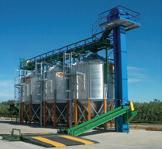

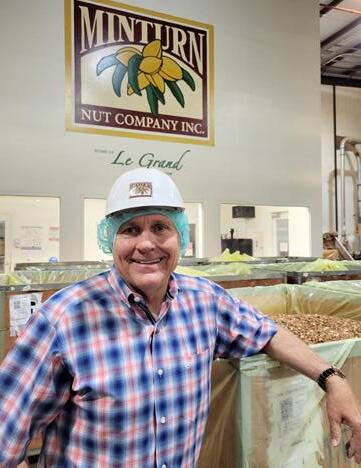
The No. 1 challenge right now is
delivering a profit back to our growers. That’s the No. 1 reason we’re in business. At this point, our growers would appreciate any profit.
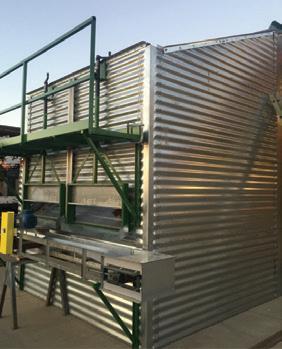
Another big challenge is the sustainability and ESG [environmental, social
and governance] policies being forced down our throats from corporate buyers and the government. I am a little disappointed how some of our industry

Kraemer & Co. Mfg., Inc. Almonds • Pecans • Pistachios Walnuts Let Kraemer & Co. Design and Build the Facility that is Right for Your Needs Nut Drying & Storage Facilities 3778 County Road 99 W Orland, CA 95963 530-865-7982 │ Fax: 530-865-5091 CA Cont. Lic. #485-547 │ Web: www.kcomfg.com • Burners • Fans • Drying Systems • Storage & Handling • Custom Manufacturing • Spiral E-Z Let Downs • Installation & Service • Knock Down Kit • Modular • Corrugated / Galvanized Construction • Do-It-Yourself Option • Low Lead Time • 6 Ton Capacity Walnut Drying Bins ContinuedonPage28
Almonds are “one of the best agricultural products on earth,” says Keith Rigg.
September 2023 www.wcngg.com 27
Employees clean and prepare lines for the new crop.
Way Forward for the Nut Industry

ContinuedfromPage27
leaders are not only accepting these policies but embracing them. It’s time to push back. We are the definition of a healthy and sustainable crop. We don’t believe these policies create the added demand suggested. These policies are hollow, phony and can become a real obstacle that does nothing but add cost to our product. The standards are always changing and are extremely subjective. These ESG policies are a way for corporate America and government to work together and have more control over our industry and take people out of business. A true return to a free market would be a breath of fresh air.
AOur growing community is worn out over it, especially at these price points. A lot of growers are sick of the government getting further and further into our businesses. I feel the same way. I just see it as a detriment to the long-term health of our industry.
Q. What are one or two of the most important things Minturn Nut has done in the last few years?


We went through a major expansion in 2018. That has helped us handle these larger crops. We built
 Under Keith Rigg, Minturn Nut has invested heavily in new equipment in recent years to improve quality and throughput.
Most of Minturn Nut’s almonds are exported.
Shipments run year-round from Minturn Nut’s LeGrand facility.
These pallets stacked with 50-pound cartons of brown-skin almonds are headed to Dubai.
Under Keith Rigg, Minturn Nut has invested heavily in new equipment in recent years to improve quality and throughput.
Most of Minturn Nut’s almonds are exported.
Shipments run year-round from Minturn Nut’s LeGrand facility.
These pallets stacked with 50-pound cartons of brown-skin almonds are headed to Dubai.
28 West Coast Nut September 2023
a large, cement tilt-up warehouse. We purchased a lot of electronic sorting equipment and processing equipment to make us more efficient and able to handle the increased volume with the same amount of employees.

Over the years, we have tried to deliver straightforward communications along with timely, competitive returns to our growers. I have been fortunate to have solid, commonsense partners as well as stable, dedicated staff. It’s a combination of that and a growing industry that’s allowed us to become the company we are today.
Q. Where is Minturn Nut headed?
I’m confident our industry is grow ing one of the best agricultural prod ucts on earth. Once we work through this oversupply and get COVID-19 fur ther in the rearview mirror, we’re going to be a very healthy industry again. Our goal at Minturn Nut is to maintain and continue to grow our share of the in dustry’s volume in a measured fashion, all while delivering a profitable return to our valued growers.
At the same time, we are going through a deep valley. None of us is having too good of a time. We have inflation, eroding equity and demand that seems to be stagnant. Put that on top of increased regulatory policies and other issues that have many people in our industry doubting what the future looks like. We will get past this, and just like in the ‘80s, once we buoy
through it, we’ll be better off having met the challenges. We’ll become more efficient, develop a better understanding of our markets and most likely see new product development along with other advancements. If every day was easy, you wouldn’t truly appreciate the good times when you have them. I have
optimism for the future, and I think Minturn Nut is going to be a big part of it.
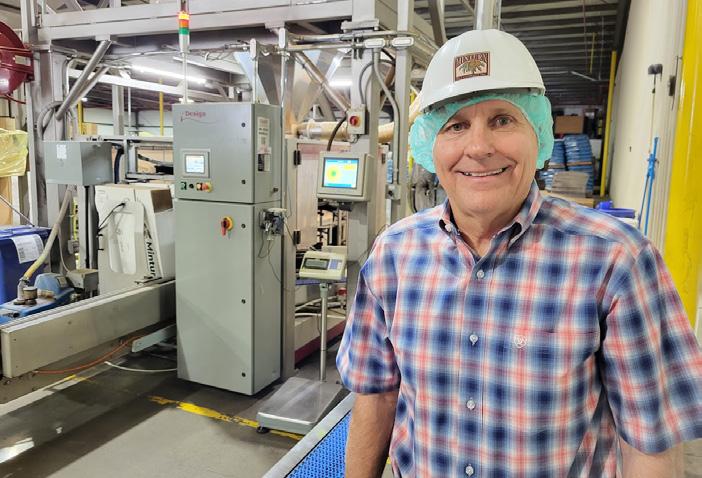
Comments about this article? We want to hear from you. Feel free to email us at article@jcsmarketinginc.com
 Minturn Nut’s Keith Rigg says socially conscious, or ESG, policies are “hollow and phony.”
Minturn Nut’s Keith Rigg says socially conscious, or ESG, policies are “hollow and phony.”
September 2023 www.wcngg.com 29
Workers install a new electric sorter at Minturn Nut in late July 2023.
the Nut
Industry Optimism in the Face of Challenging Times
By MARNI KATZ | Editor
While acknowledging that growers are coming off difficult times in the almond and walnut industry, handlers and industry leaders recently expressed optimism for the coming season.
“That optimism comes from us saying we’ve hit rock bottom and the only way to go is up,” John Rodriguez, grower relations manager with Mariani Nut Company, said half-jokingly.
In fact, he and others noted, after a devastating season for many walnut growers, indicators for the upcoming crop and marketing outlook were very positive.
Prolonged heavy rains and a deep snowpack last winter have helped recharge aquifers and reservoirs in California and a deep winter chill followed by ideal spring conditions have all led to a forecast for excellent crop quality. At the same time, some of California’s leading competitors in the world market, including Chile, will be running out of supply, opening channels for California walnuts.
“This year, our trees are more capable of handling higher temperatures than the previous years when the trees were under stress due to long-term deficit irrigation,” commented fourth-generation grower and handler Bill Carriere of Glenn, Calif. “Long-time growers have commented that the trees have not looked this strong and healthy in at least six to seven years. The full leaf canopy provided excellent temperature control and sun protection during the spring and summer
months, allowing the walnuts to grow evenly with minimal sunburn. I am very optimistic that this year will mark a return to the premium quality walnuts we are known for in California.”
Like many growers, Don Barton this year pulled acreage of legacy walnuts in light of sinking markets. This reflects a natural shift in acreage following the market downturn. While acknowledging the pain of removing a productive orchard, he noted “things are looking more hopeful going into the 2023 harvest season.
Last year was characterized by record carryover, a large crop, a strong dollar and a clogged pipeline, Barton noted. This year has been flipped on its head, creating a much better outlook for 2023-24.
Barton said carryover is heading in the right direction, surveys reveal a more balanced supply of high-quality California walnuts, and the dollar has dropped 10 percent from last year, all creating strong pull for new crop walnuts from California.
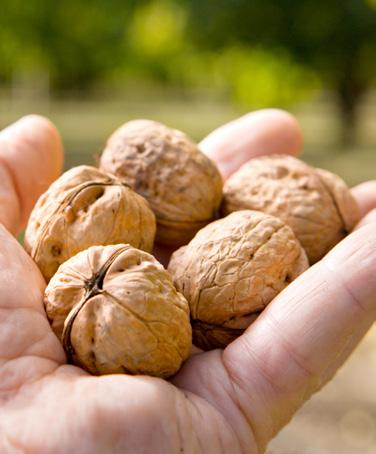
“As rough as 2022-23 was, 202324 is certainly looking more promising,” he said.
An acreage survey conducted by the California Walnut Board between October 2022 and July 2023 revealed for the first time ever that the acreage of California walnuts declined, with 23,000 acres removed during the nine-month period. The industry will likely see additional reductions between July and
December 2023, as more growers decide
to shift to other crops
According to the Walnut Board, even with the removal of these orchards, the industry has a strong production base with approximately 380,000 producing acres and 37,000 younger non-bearing acres.
“[In August] the California Walnut Board released the monthly and year-to-date shipment report which highlighted an additional reason why I am bullish about the upcoming season,” remarked Martin Mariani, a grower/processor from Winters, California, “The data shows that we have shipped the equivalent of 730,488 tons this season from an available inventory of 880,000 tons.”
He went on to explain that when taking into consideration the high sales commitments going into the fall, “we are virtually sold out of available inventory, which bodes well for the industry. I can’t wait to bring the new crop to market.”
With a focus on inshell markets, Chile is anticipated to be sold out by the time the new California crop starts shipping this fall, the board reported. With minimal inventories of export-quality walnuts on hand, coupled with the current limited supply of walnut halves in global markets, the fresh California crop of premium quality walnuts, inshell and kernels, will be in high demand.
“Domestically, sales have increased 28% which helped our industry work through the high inventory numbers we saw at the start of the season” said Mike Poindexter
A Way Forward for
Industry 30 West Coast Nut September 2023
The quality and supply outlook for California walnuts has greatly improved from last year.
of Poindexter Nut Company in Selma, California. “Major US retailers significantly increased their promotional efforts, which stimulated consumer sales. This is continuing through the fall and will provide nice momentum going into the U.S. holiday season for new crop kernels and inshell sales.”
Acknowledging the difficulty California walnut industry growers have faced in recent years, Robert Verloop, CEO and Executive Director for the
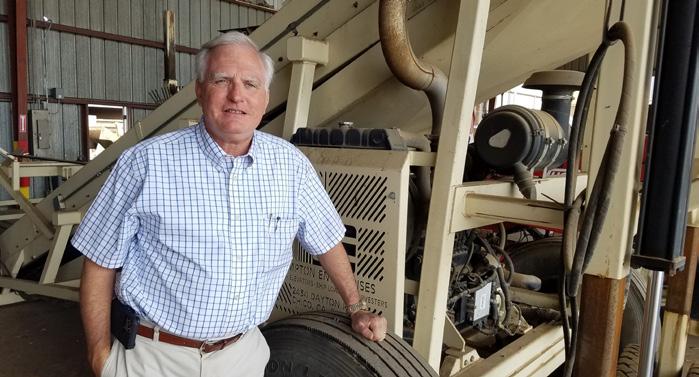
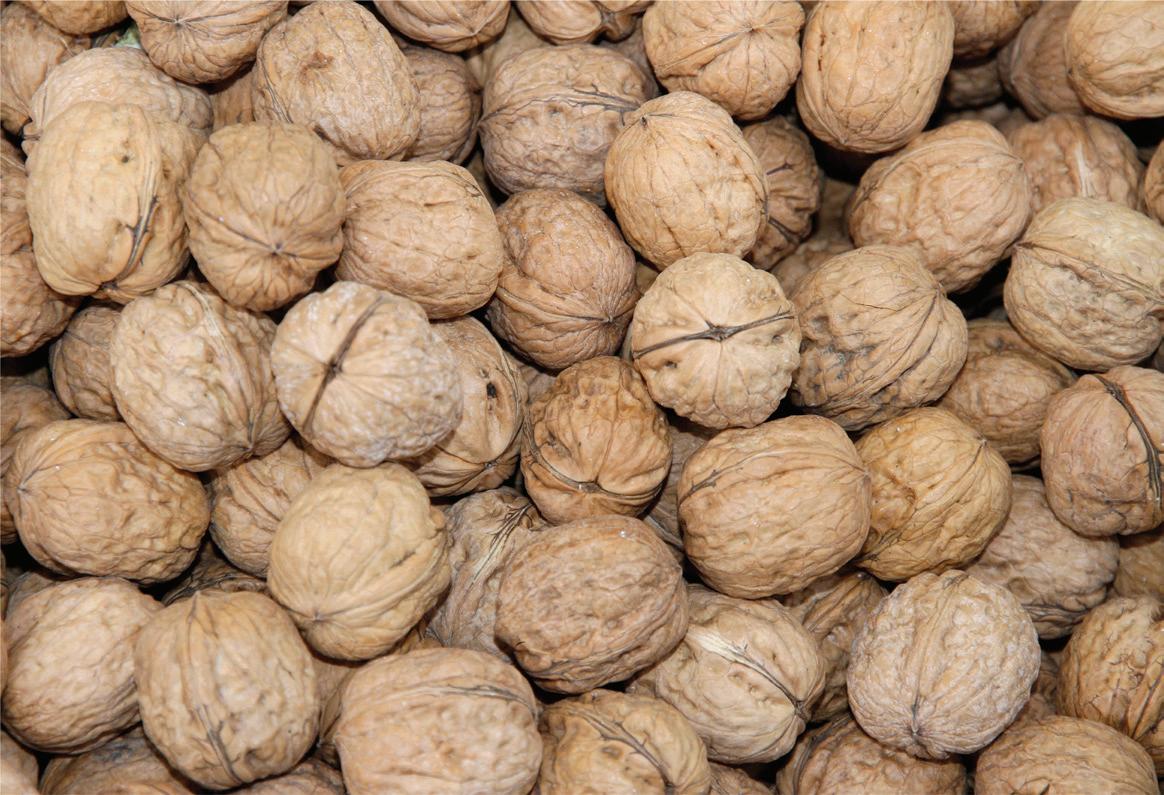
and Board, said the organization is working to secure emergency relief for walnut growers.
“Also, working with the CWC Board of Directors, industry handlers/processors, many volunteer leaders and elected officials and regulators, we have successfully secured a record USDA Section 32 purchase this season for up to $90 million,” Verloop said. “This funding is being used to help move the current crop out of our storage and
providing additional nutrition to thousands of families. In addition, the 20% reduction in tariffs recently announced by India will help us regain our footing in the Indian market.”
Mike Kelley, president of the central California Almond Growers Association, a cooperative huller/sheller made up of 350 smaller growers, said that despite its difficulties the almond industry still has an excellent story to tell in terms of its quality and health benefits that will keep propelling California forward.
“This industry is going to be around for a long time. We are blessed to have an environment here that is conducive to growing almonds and we produce a crop that provides excellent health benefits to consumers,” Kelley said.
Comments about this article? We want to hear from you. Feel free to email us at article@jcsmarketinginc.com
WalnutTek Advantages
• Walnut sorting at the huller, and in-shell
• Green and black re-sorting at the huller
• Several width options — 32, 48, 64 or 80in
• Capacity from 5-30 tons/hour
Automated Moisture Monitoring at the Dryer
All moisture meters are available for use individually or in conjunction with the WalnutTek sorter.
• Hand-held moisture meter
• Automated moisture meter
• Automated moisture meter with door control
• Automated moisture meter with door control
• and bin fill
AgTrack
• Traceability from the farm-to-processor
Woodside Electronics Corp.
1311 Bluegrass Place, Woodland, CA 95776
Phone: 1-530-666-9190
• Fax: 530-666-9428
Website: www.wecotek.com
Chris Sinclair 530-979-7633

16 Years in Walnuts | 30 Years of Sorting in the Field LOCAL FULL SERVICE! TECHNICIANS AVAILABLE 24/7
September 2023 www.wcngg.com 31
Mike Kelley, President of CCAGA, said despite difficulties the almond industry will continue to move forward.





NOVEMBER 2, 2023 4PM - 8PM JASON SCOTT CEO OF JCS MARKETING, INC. YOU’RE INVITED TO THIS ONCE IN A LIFETIME EVENT JESSE WATTERS CO-HOST OF FOX NEWS KEYNOTE SPEAKER EVENT HOST INTERNATIONAL AGRI-CENTER 4500 S LASPINA ST, TULARE, CA 93274 MYAGLIFE.COM/MYAGNITE SCAN THE QR CODE OR VISIT FOR MORE INFORMATION FEATURING THE CO-HOST OF FOX NEWS JESSE WATTERS SEATING IS LIMITED AND WILL SELL OUT STARTING AT $150 PER PERSON AGENDA MIXER / TRADE SHOW - 4PM - 6PM GOLDEN HARVEST GALA DINNER - 6PM - 7PM KEYNOTE - 7PM - 8PM MIXER AND TRADE SHOW IN THE FARM CREDIT BUILDING GALA DINNER AND KEYNOTE SPEAKER IN THE CORTEVA BUILDING AG MARKETING SOLUTIONS POWERED BY
Fox News Host to Headline My Ag Nite Event in Tulare
Political commentator and Fox News co-host, Jesse Watters, will be the headliner at a premiere ag event coming to the heart of the Central Valley on November 2. My Ag Nite, hosted by Jason Scott, CEO of JCS Marketing, Inc., will bring together industry professionals and conservative dignitaries to celebrate all things California agriculture.
The dinner and gala will take place at the International Agri-Center in Tulare, Calif., and is expected to sell out. Guests will have access to an exclusive trade show showcasing innovative farming solutions, and the opportunity to network and forge connections within the industry.
Scott said he sees the night as a way to bring those who have a stake in agriculture together in one place to celebrate the industry and to wind down and enjoy like-minded solidarity following the stresses of the busy harvest season.
“We’re bringing a diversified group of thought leaders together to celebrate leadership in agriculture,” he said.
Scott is especially excited about the event being able to present a rare, in-person opportunity to hear from a political commentator of Watters’ caliber that will appeal to the conservative farming community. Watters’ notoriety has skyrocketed since he took over for former Fox News commentator, Tucker Carlson, who left the network earlier this year.
The chance to see Watters speak isn’t likely to come around again to this part of the state, Scott said, and
will no doubt make the event memorable.
“We expect this to be one of the best events that we’ve ever put on or will put on,” Scott said. “If you want to attend something that’s different, unique, and special to agriculture, this is the one time you need to make time to show up.”
Scott's firm publishes both print and digital trade magazines. The publications include West Coast Nut, Grape & Wine and Progressive Crop Consultant. Scott's firms also hosts a growing website called MyAgLife, which highlights the diverse agriculture commodities of the West Coast. The site is also home to a daily and weekly podcast highlighting Central Valley ag issues and leaders.
Coming out of a post pandemic reality, Scott came up with the idea for My Ag Nite as a way to stimulate live events, he explained. Like the MyAgLife website and brand, he emphasizes the event being about agriculture as a whole, and not focusing on any one commodity.
“We wanted to do something unique in the industry, for the industry, and we wanted to provide something for the MyAgLife brand,” he said. “The idea behind it is that we celebrate agriculture and our conservative values in the industry.”
Scott says that while he tends to leave politics out of his publications and marketing, he sees My Ag Nite as a way for those who have a stake in agriculture to be able to talk about the issues that affect them first hand—with

the successes and failures of those issues so often being determined by politics.

“I feel like agriculture is in a place where it’s time to get back to basics, it’s time to celebrate a lot of the things we have in common, and be able to come together and talk about it for an evening,” he said.
Scott added that he wants people to walk away with renewed relationships, a better understanding of who ag is as an industry, and the challenges ag faces collectively, as a group.
“I hope attendees will walk away with a sense that not all is lost with conservative values and we don’t stand alone in that community,” he said
Tickets for My Ag Nite start at $150 per person and a number of upgraded ticket opportunities are also available, including a meet and greet with Watters, group table reservations, and trade show booth space. Tickets and further information can be obtained through www.myaglife.com/myagnite. Ag media inquiries only can be directed to the JCS Marketing Office (559) 352-4456. No outside media outlets beyond agriculture.
About JCS Marketing:
JCS Marketing has a rich history in providing marketing services tailored to the agricultural industry. With a deep understanding of the unique needs and values of the ag community, they are committed to fostering connections and driving success within the industry.
the
GROWER PROSPERITY, EXPANDING DEMAND DRIVE WALNUT INDUSTRY’S NEW COLLABORATIVE ROAD MAP
By CATHERINE MERLO | Contributing Writer

Walnut growers, take heart. A new strategic plan to drive profitability and broadly expand demand is about to spring into action to strengthen California’s struggling walnut industry.
Spearheaded by the California Walnut Board and its sister organization, the California Walnut Commission, the plan calls for bold steps to go where walnuts haven’t gone before.
The new road map not only proposes taking walnuts way beyond the baking aisle; it sets its sights on making consumers around the globe crave California walnuts. It outlines six priorities for improving quality, developing innovative products and packaging, and activating sales to increase global customers and consumption avenues.
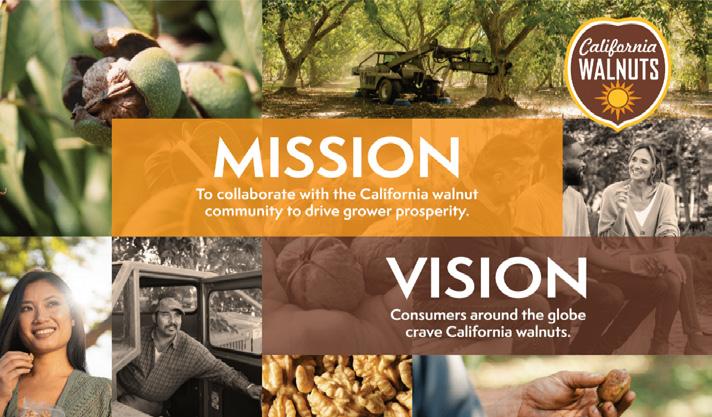
At its core, however, the plan identifies “grower prosperity” as its mission, said Robert Verloop, president and executive director of both the Board and the Commission.
That’s critical since current conditions are not sustainable for walnut producers. For 2022, most growers were paid only half of their cost of production, said Gordon
Heinrich, a fifth-generation walnut producer from Modesto, Calif. He is also part of the 17-member Strategic Planning Task Force that shepherded the strategic plan through its seven months of development.
“One reason this strategic plan is so important is its mis sion to turn the ship around to sustain growers,” Heinrich said. “If
“We’re tackling today’s issues as well as preparing for tomorrow,” said Sacramento Valley Walnut Growers’ Kiran Black of the new strategic plan (photo courtesy Sacramento Valley Walnut Growers, LLC.)
“This plan inspires me and gives me confidence,” said walnut grower and taskforce member Gordon Heinrich. “It brought our whole industry together.” (Photo by C. Merlo.)
As president and executive director of the California Walnut Board and Commission, Robert Verloop will help turn the plan’s words into action (photo courtesy California Walnut Board.)

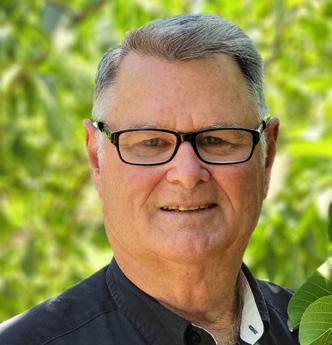
A Way Forward
Industry 34 West Coast Nut September 2023
Collaboration is a key component to the success of the new strategic plan.
for
Nut
growers are not prosperous, the whole industry will die. If growers prosper, the whole industry wins.”
The new industry strategies, or pathways, were developed with industrywide input from January to July of this year. Participation came from all segments, including growers, hullers, processors and handlers as well as the Board and Commission. The public relations firm of Nuffer, Smith, Tucker served as the process’s strategic planning partner.

The strategic planning process included in-depth interviews with 35 walnut growers, handlers and walnut stakeholders. Three grower roundtables were also held to gather input. An electronic, anonymous survey, open to all in California’s walnut industry, drew more than 650 responses. Global marketing agencies also provided their insights. Drafts of the plan were previewed at public meetings.
Something to Rally Around
With the plan, “the industry is taking an active role to create a thriving and prosperous industry,” said taskforce member Kiran Black, sales director for
Sacramento Valley Walnut Growers, LLC, a grower-owned walnut processor. “The plan is exciting and gives us some-
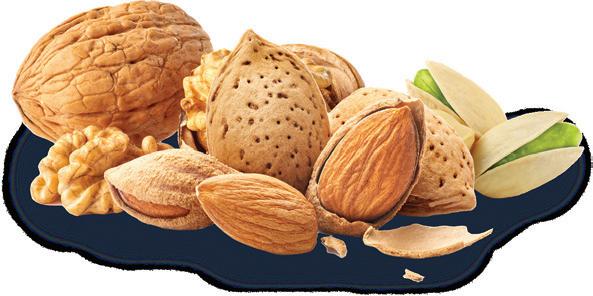

ContinuedonPage36 From Lab to Field Partnering with the best to provide quality trees and service WALNUTS VX211 RX1 Vlach Grafted PISTACHIO UCB-1 ALMONDS Nonpareil Monterey Butte Padre CONTACT US TODAY 916-605-0463 sales@baselinenursery.com 3556 Sankey Rd. Pleasant Grove, CA 95668
September 2023 www.wcngg.com 35
Strategic priorities of the new plan.
A Way Forward for the Nut Industry
ContinuedfromPage35
thing to rally around.”
Black is especially encouraged by the plan’s pursuit of multiple and largely untapped opportunities for walnuts in the supermarket, food service and food manufacturing segments.

an ag commodity to adding value and evolving to the next stage of marketing: becoming part of the food culture,”
she said. “The more we amplify and spread the message of walnuts and their great health benefits, the more we help walnuts go from just being a snack food into other eating opportunities.”
A Closer Look at the Game Plan
The 12-page plan, “Driving Grower Prosperity for California Walnuts,” substantiates its six priorities with specific targets for the next five years. Here’s an overview: Delivering the best quality California walnuts. One objective is to revise grades and standards to ensure the highest quality product, Verloop said. The Board and Commission as well as industry stakeholders will engage in efforts throughout the supply chain to implement best practices and tackle challenges such as rancidity.
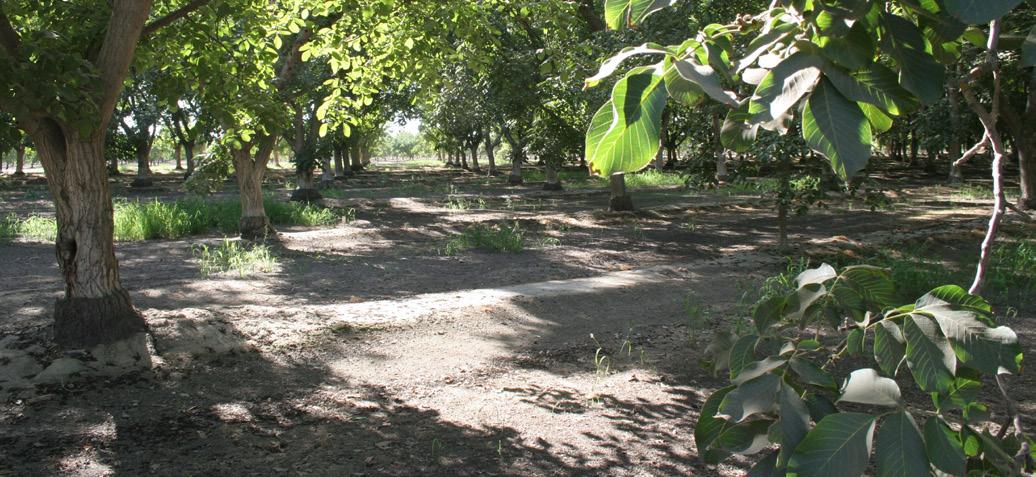





Activating sales of California walnuts through global The Board and Commission will serve as the champion for California walnuts in retail, food service and food manufacturing and ingredient channels. That will include leveraging health research to build consumer awareness and spur sales.
“A key component at the onset is extensive consumer and marketplace research that will provide sound data and insights to drive continuous learning,” Verloop said. “From the research, corrective measures will be made as plans are implemented.”
 To improve production and post-harvest practices, the Walnut Commission and Board will seek to uncover “pain points” among growers and handlers (photo by C. Merlo.)
Moving walnuts beyond the baking aisle and into the produce section is just one goal of the new strategic plan (photo by C. Merlo.)
To improve production and post-harvest practices, the Walnut Commission and Board will seek to uncover “pain points” among growers and handlers (photo by C. Merlo.)
Moving walnuts beyond the baking aisle and into the produce section is just one goal of the new strategic plan (photo by C. Merlo.)
36 West Coast Nut September 2023
Fostering innovation to de-commoditize California walnuts. As part of the plan’s unprecedented focus on innovation and fresh ideas, the industry will engage partners to help commercialize new products. “Innovation will no longer sit solely on the shoulders of handlers but rather be driven by the Board and Commission,” Verloop said.


Defining the sustainability story as a point of differentiation for California walnuts. This priority won’t only define what sustainability means to California’s industry. “We will be looking at sustainability requirements from customers and regulators across the globe and seeing how the California walnut industry stacks up in order to develop a sustainability scorecard,” noted Verloop.
Supporting goal-oriented research to improve production and postharvest practices. Verloop said he and his staff will be talking with growers and handlers “to better uncover pain points.” Moreover, 100% of funded research will go toward industry-identified needs. The Commission and Board also will seek opportunities to leverage outside research dollars.
Revitalizing the Board and Commission and aligning on advocacy efforts. “We are upping the ante on grower communication and engagement,” said Verloop. Further, he, board members and staff will look at all areas of governance to ensure the two grower groups are set up for success and represent the industry’s diversity. It’s important the California walnut industry has a seat at the table in Sacramento, Washington, D.C., and with local elected officials, he added.
Verloop said more details of the strategic plan will be released later this year as its annual tactics are developed. Each priority area will contain SMART (Specific, Measurable, Achievable, Realistic, Timely) objectives, “so we can track our progress and adjust as required,” he said.
“The Board and Commission will provide annual recaps to the industry so that progress is transparent and all stakeholders understand the continuous learning process used to pave new directions for the industry,” Verloop noted.

Members and staff of the Board and Commission also will meet one on one with California walnut growers in a variety of settings to explain “how we’ll
go from words on paper to an action-oriented plan,” Verloop said.
Those involved in the strategic plan say it remains a work in process.
“We’ll evaluate it on a regular basis,” said Heinrich. “As markets change, strategies will change, and we’ll tweak them to our benefit.”
In the meantime, “the real work has just begun,” Black said. “Now we need to work together to achieve its goals and objectives. We all have to actively partic-

ipate and hold ourselves accountable.” Verloop agreed. “Collaboration is critical,” he said. “We can’t do it alone, and everyone in the California walnut community must work together to bring the plan to life and create a prosperous future.”
Comments about this article? We want to hear from you. Feel free to email us at article@jcsmarketinginc.com

IT THRIVED WHEN ALL THE REST BARELY SURVIVED! ™ Choose the Bigger, Stronger, More Productive Tree For Your Next Orchard Planting WWW.GRIZZLYWALNUT.COM NEW WALNUT ROOTSTOCK
vigor and highest stress tolerance
for best performance in replant sites CONTACT THESE LICENSED NURSERIES Sierra Gold Nurseries MicroParadox/Baseline 2nd Leaf Chandlers Replant Orchard Trial Burchell Nursery Agromillora Nursery SUBSCRIBE TO US ON YOUTUBE GRIZZLY VX211 September 2023 www.wcngg.com 37
25 years of observation Top tree size and nut yields in multiple trials Highest
Selected
INDIA TARIFF REDUCTION COULD HELP RECAPTURE AND BUILD ON MARKET SHARE
By MITCH LIES | Contributing Writer

Tree nut industry leaders applauded India’s agreement in June to lift retaliatory tariffs on U.S. walnuts and almonds, with California walnut executives particularly pleased after losing significant market share over the last four years.
“We lost tremendous market share during the time that we have had this 20% retaliatory tariff,” said Pam Graviet, senior director of global programs for the California Walnut Board and Commission. “Being on a level playing field really opens up that opportunity for walnuts from California to become more affordable.”
In almonds, the retaliatory tariff was 6 rupees per kilogram, or roughly 7 cents a kilogram, not nearly as high as in walnuts. But Richard Waycott, CEO of the Almond Board of California, said the industry still welcomed the relief.
“In terms of economic impact per kilo, it’s not
that significant,” Waycott said. “But it will be a little cheaper (for importers), and that will follow through to the consumer. So, it’s good news.”
India imposed retaliatory tariffs on walnuts, almonds and other U.S. goods in 2019 in response to tariffs the U.S. imposed on Indian steel and aluminum imports in 2018.
The retaliatory tariffs in walnuts came on top of a 100% tariff India imposed on all walnuts entering the country in May 2018 (up from a previous tariff of 30.9%), a tariff which continues today.
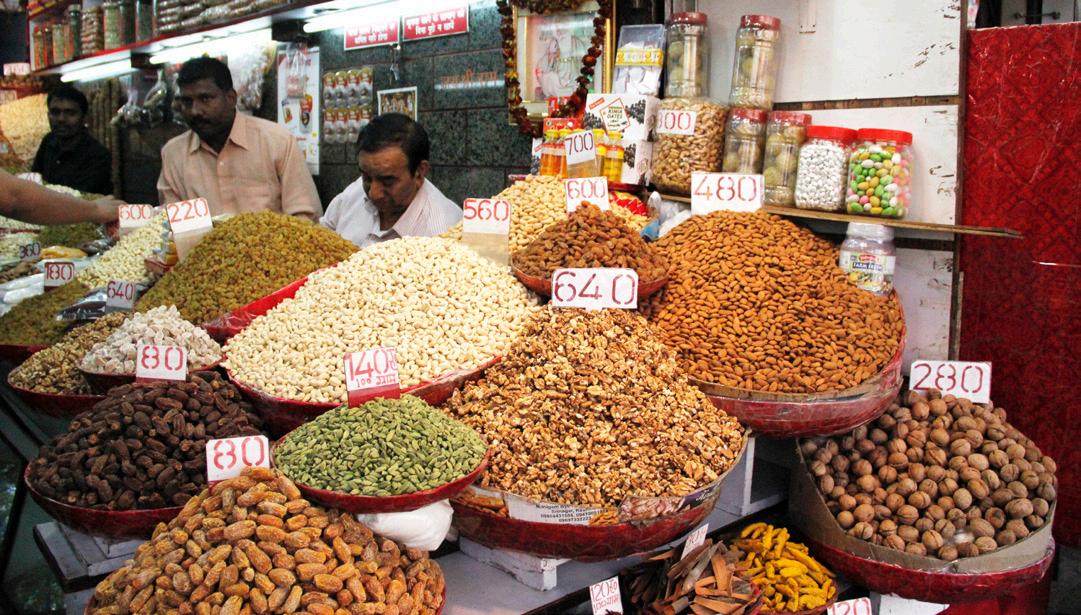
California walnut exports to India subsequently dropped from 16,000 short tons at their peak in the 2016-17 crop year to just under 4,000 short tons last year, Graviet said.
Market Potential
In the meantime, India’s market potential for walnuts has continued to develop, said Robert Verloop, CEO and executive director of the California Walnut Board and Commission.
“If you take a look at the population growth in India over the last decade, and particularly the last five years, they have a younger population base,” Verloop said. “They are becoming more affluent. And they are a plant-based eating culture. The younger generation is also looking for more diversity in their food choices and looking for more international flavors. So, you’ve a lot of things in our favor to expand walnut penetration in various markets, whether it’s the high-density markets of the smaller tier-2, tier-3 or tier-4 markets.”
“We are expecting to see a significant change from where we have been the last couple of years,” Graviet said.
Walnut sales to India, which purchases almost strictly in-shell walnuts and in fact has an industry dedicated to hand cracking the nuts, were on a steady climb over the past
A Way Forward for the Nut Industry 38 West Coast Nut September 2023
Tree nut executives say a plant-based diet, growing affluence and young demographic make India ripe for growth (photo courtesy Almond Board of California.)
decade, Graviet said. Sales peaked as the 10th largest export market for California walnuts in the 2016-17 crop year, and Graviet believes if the retaliatory tariff had not been instituted in 2019, India could now be among the industry’s top export markets.

“If the market hadn’t been constrained by these barriers, looking at the change in Indian demographics and consumption patterns, there was speculation that it would easily have been in our top three,” Graviet said. The industry has put significant
resources into developing the market, particularly through the USDA Market Access Program, Graviet said, and has developed strong trade relations with importers, traders, distributors, processors and retailers. “In spite of the
ContinuedonPage40
Contact us to see how we can help! (559)584-7695 or visit us as www.superiorsoil.com Serving California since 1983 September 2023 www.wcngg.com 39
The industry has put significant resources into developing the market through strong trade relations with importers, traders, distributors, processors and retailers (photo courtesy Almond Board of California.)
A Way Forward for the Nut Industry
ContinuedfromPage39
challenges, we have continued to invest in the Indian market through our integrated consumer and trade programs along with educating healthcare professionals about the health benefits of walnuts,” Graviet said.
Verloop added the timing of the tariff reduction couldn’t be better.
“We’re looking at the new crop year coming in here with great crop conditions and sufficient supply,” he said. “So, in many ways, this is a wonderful year to reintroduce ourselves with maximum volumes.”
“The timing is exceptional,” Graviet said.
Plenty of Supply
Almonds, too, have plenty of supply to meet an increase in demand from India, Waycott said.

“The reduction in tariff will be beneficial for Indian demand, and there will be plenty of supply,” Waycott said. “We entered the 2022-23 crop year with the largest inventory that we’ve had as an industry, about double what we normally have.”

Going forward, Waycott said the bigger issue for California almonds in India is getting on even footing with Australia, which in January of this year struck a bilateral trade agreement with India to lower their tariff by 50%.

“So, currently, Indian importers can import Australian almonds at 50% of the duty that they need to pay for U.S. almonds,” Waycott said. India’s current tariff on almond imports from California is 35 rupees per kilogram, compared to 17.5 rupees per kilo for Australian almond imports.
“That is the more significant situation right now for us in that we have the competitive factor there that is putting us at a disadvantage,” Waycott said.
Despite the retaliatory tariff on California almonds, which increased the tariff to 41 rupees per
Advocates hope to apply the successes in India to other key export markets such as China (photo courtesy Almond Board of California.)
The California Walnut Board has continued promoting California walnuts in India while the tree nut faced a 20% retaliatory tariff (photo courtesy California Walnut Board.)
40 West Coast Nut September 2023
kilogram between 2019 and this year, other than a slight slippage in exports in 2020 and 2021, a slippage induced at least in part by COVID-19, India has been a consistent growth market for California almonds, Waycott said.
“Generally speaking, it’s been a growth market for us, and the tariffs haven’t been debilitating,” Waycott said.
India is by far the largest export market for California almonds, Waycott added, and the industry has invested heavily to support the market.
“The Almond Board of California has been actively involved in India for 25 years, and we’ve had what we call an integrated consumer program there for the past 15 years,” Waycott said. “And today, it’s the largest investment that we make in terms of growing demand and market development outside the U.S.”
He added the industry has yet to notice any direct impact of the January 1 India-Australia bilateral agreement, but he expects it could be significant.
“It’s early days and the Australian crop was quite reduced this year, so it is a little hard to tell,” he said. “But certainly, their exports have increased, and we expect that to be the case until hopefully the American government can negotiate some type of similar agreement [with India].”
Waycott noted the counter-seasonal aspect of Australia’s almond produc tion can help California almonds overcome the economic disadvantage it operates with in India, particularly in fall and winter months as buyers typically prefer to purchase the freshest product possible.

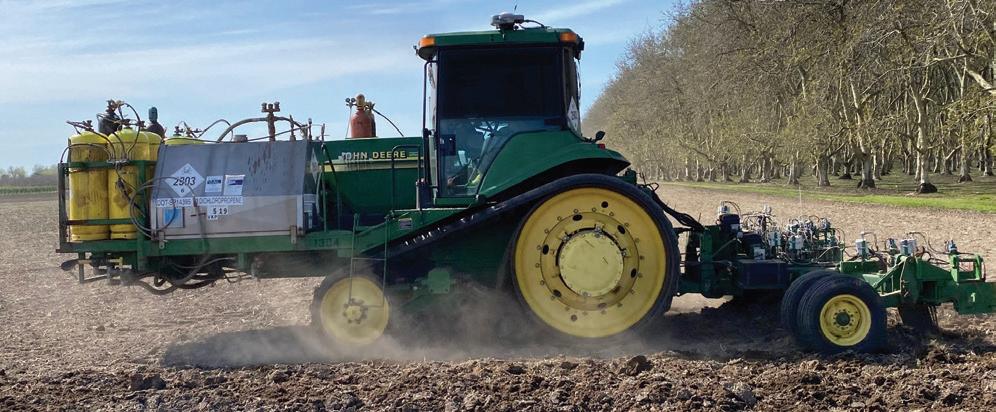
“But, having said that, almonds are very shelf-stable products,” he said. “So, old crop doesn’t become old for a couple of years.”
Other Export Challenges
Perhaps an even bigger issue for almond exports, Waycott said, is the extreme market advantage Australia enjoys over California almonds in China, which imposed a much higher tariff on California almonds in response to U.S. tariffs on not only Chinese steel and aluminum imports, but also on a variety of other goods from China.
Also at play in China is Australia now operates in the Chinese market
under a free trade agreement.
“In China, we are currently at 55%, but there is a 30% exemption that Chinese importers can apply for and are being granted,” Waycott said. “That takes our effective tariff down to 25%, but we are still at the disadvantage of a 25% tariff versus Australia, which negotiated a free trade agreement with China about three years ago.”
Waycott said he hoped to see a resolution to the issue soon but as of July had not seen any movement.
“I think the fact that Secretary Blinken and Secretary Yellen have been in the country recently and have been having discussions with Chinese officials is encouraging,” he said. “We have not seen any movement at all yet in the discussions of pulling off those tariffs, but I think the fact that they are talking is a good thing.”
Comments about this article? We want to hear from you. Feel free to email us at article@jcsmarketinginc.com
THE BEST WAY TO MANAGE PATHOGENS BEFORE THEY BECOME AN ISSUE.
*TriClor and Telone are federally Restricted Use Pesticides. 669-327-5076 www.TriCal.com Authorized distributor for Telone® September 2023 www.wcngg.com 41
TriClor is chloropicrin based and can be used as a standalone or as a complement to Telone® depending on your orchard redevelopment needs. When targeting soil borne disease and nematodes, TriClor and Telone® can be applied in a single pass. This reduces application costs, promotes early root development, and improves soil health. For more information about TriClor and Telone or to schedule an application contact TriCal, Inc.
Navel orangeworm (NOW) is known to be one of the most important insect pests of almonds and pistachios, but it’s also one of several key pests for walnuts. Its degree of importance in walnuts often depends on when and where an orchard is located, according to Chuck Burks, a research entomologist with USDA, who has been studying NOW since 2000.
Much of Burks’ work has focused on monitoring and mating disruption and has helped to develop and define some of the mating disruption systems used today. Recently, he has been trying to improve the ability to predict when and
A New Look at Monitoring and Mating Disruption for Navel Orangeworm in Walnuts
 By KRISTIN PLATTS | Contributing Writer
By KRISTIN PLATTS | Contributing Writer
where NOW is going to be problematic for walnuts.
Unfortunately, foretelling NOW’s next move is anything but exact. Burks said monitoring research for NOW continues to take place in part because predictions of the pest have always been difficult and continue to be difficult.
“Our crystal balls don’t work that well,” he said.
The pest has a very strong reproductive capacity as well as a strong ability to disperse, Burks explained, particularly to neighboring or adjacent orchards.
“It has a wide host range, but it does particularly well on the tree nuts,” he said.
As the tree nut industry has grown substantially and various tree nut crops move closer to one another, it has expanded the ability of NOW to take advantage of the earlier harvest varieties of almonds before jumping over to pistachios and walnuts.
“Because of the acreage expansion, they are more likely to be in the vicinity,” Burks said.
NOW affects other crops like figs and pomegranates, but its economic impact is mostly felt by the nut industry. It seems to do particularly well on earlier-bearing varieties, while Chandler, which has seen the greatest acreage expansion in recent decades, fares the best.
“Chandler is the least susceptible walnut variety since it’s the latest harvested,” Burks said. “But NOW can still cause problems for Chandler, particularly if it is in the vicinity of other nut crops.”
NOW is a pest that can have a potentially explosive growth and can get severely out of hand, according to Burks, who recalls seeing damage above the 20% range in some locations in the past. Those cases, he noted, are typically due to a combination of factors, such as a wet spring, or a lack of
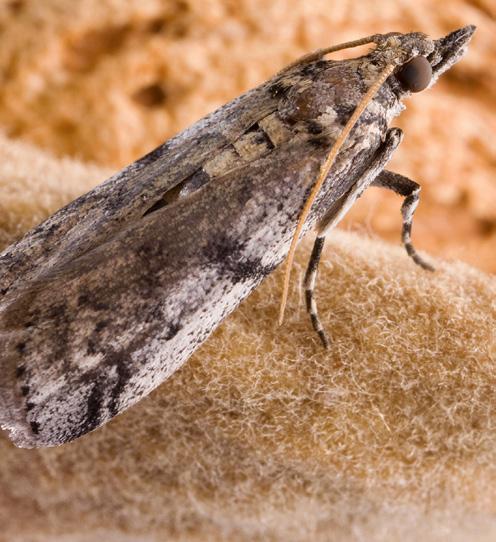 Recent USDA research efforts are trying to improve the ability to predict when and where NOW is going to be problematic for walnuts (photo by Patty Grebs, USDA.)
Recent USDA research efforts are trying to improve the ability to predict when and where NOW is going to be problematic for walnuts (photo by Patty Grebs, USDA.)
42 West Coast Nut September 2023
Later varieties are less susceptible to NOW in walnuts, according to researchers.
labor when sanitation isn’t able to happen as efficiently, or even a later-generation moth coming in ahead of the split on one of the crops.
“It can lead to some pretty heavy economic loss if people get caught off guard,” he said.
The damage from NOW on walnut crops won’t often be very apparent, since the pest is an internal feeder and requires some type of an entry point.
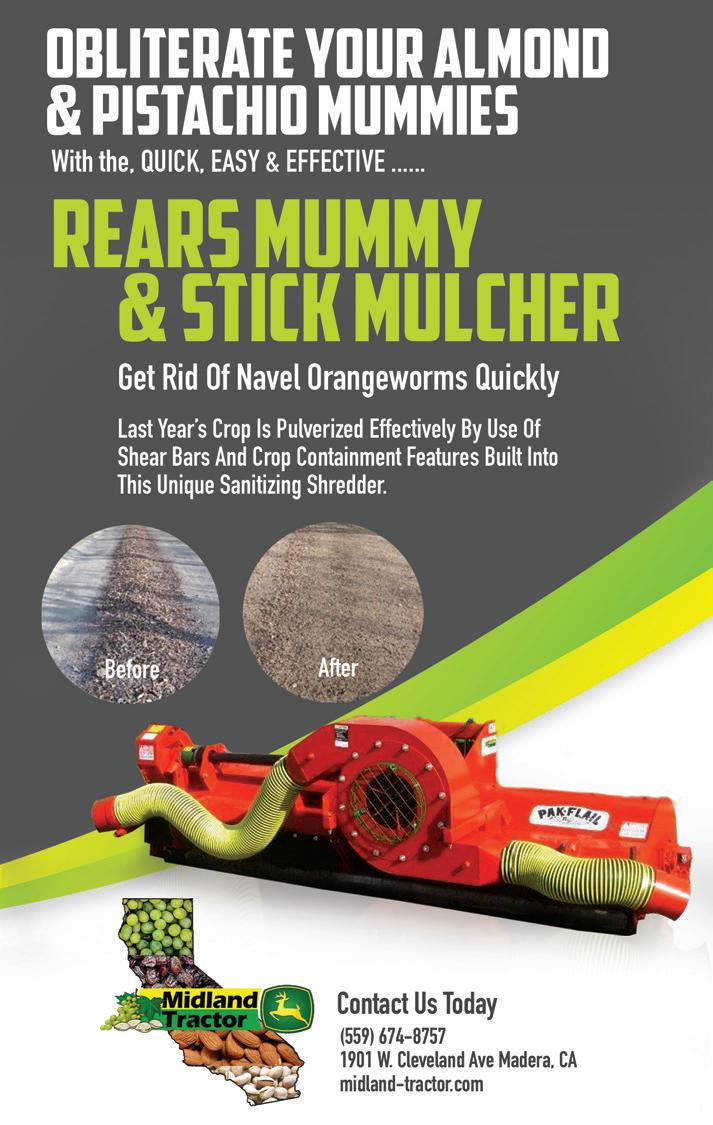
While walnuts aren’t inherently susceptible to NOW prior to husk split, late into August and into September, depending on the variety and the year, diseases like walnut blight, sunburn or codling moth can cause the nuts to become susceptible to NOW earlier.
The degree of NOW’s abundance has historically been related to the amount of heat units an area receives during the summer, Burks explained. That means regions like the Southern San Joaquin Valley will see more generations than places like the Northern Sacramento Valley or the cooler Delta regions. Although he said that doesn’t mean those areas will be free from NOW, particularly as nut crops are planted more closely together.
“Of course, if you get a situation where there’s a more general warming over the entire area, that will drive more generations,” he said.
NOW Treatment Options
Ways to treat for NOW in nut crops typically include mating disruption or pesticides. Burks said mating disruption is a very good option for pistachio and almond but might not always be the way to go for walnuts.
Mating disruption is most successful when taken as an area wide approach, and since it’s not easy to tell if a situation is coming from within your own orchard, versus if it’s coming from a crop outside your orchard, it makes mating disruption a bit more difficult, he explained.
“Because mating disruption is a birth control method, if your problem is coming from within your orchard, it might be valuable,” Burks said. “But if your problem is coming from other orchards, or other crops in particular, then mating disruption is less likely to be valuable.”
That’s because moths coming in from outside an orchard are likely to have already been mated before they move in.
“Since mating disruption is preventing mating, if mated moths come in, then it really does not have any effect on them,” Burks said.
Other treatment options for NOW in walnuts include husk split insecticides, and recent research funded by the California Walnut Board has aimed
to use monitoring to recognize when those treatments are useful and when they are not needed by determining if moths are coming in from the outside.
“That’s work we did over several years with different monitoring approaches,” Burks said.
In terms of treatment challenges over the next period of years, Burks
ContinuedonPage44 September 2023 www.wcngg.com 43
said insecticides for NOW treatment are going to be more constrained, with growers being pushed into a situation where they will be more dependent on materials with low, non-target effects.
“So, things like mating disruption, cultural control, other biorational techniques and area-wide approaches will become more important with time,” he said.
Mating Disruption Study in Walnuts
A current UC study that began in late spring and will conclude at harvest is examining mating disruption in six walnut orchards in two regions; three in the Northern San Joaquin Valley and three in the Sacramento Valley.

The trial is comparing between minimum 40-acre blocks, each with mating disruption and without, keeping other factors the same for both blocks, explained Dr. Jhalendra Rijal, UCCE IPM advisor for the northern San Joaquin Valley. The study is being conducted in collaboration with the California Walnut Board and the private industry.
Rijal said the trial includes orchards with both high and low NOW pressure, with the goal being to compare different scenarios.
“So far, we’ve seen the pheromone “trap shutdown” which you would expect from mating disruption as it hinders male moths’ ability to find females for mating, and we’re getting that on these different blocks,” he said. “So, we’re happy with the performance so far, but the ultimate performance would be to evaluate the nut damage between these two plots, and that would be at harvest time.”
Outside of the study, Rijal said he’s not seeing any major trends of note with NOW right now except the second flight began later than the previous years, and this is true for other major insect pests up and down the valley this year due to the exceptionally cooler spring and early summer. But Rijal emphasizes every orchard is different, and NOW prevalence can vary from orchard to orchard.
“Some orchards, when they have a history of damage, or other NOW host crops nearby, those orchards likely get more damage than the others,” he said.
Rijal said growers will need to be cognizant of NOW’s third and fourth flights; after husk split, trees are vulnerable.
“Third generations, which start around early to mid-August or so, depending on where you are at in the Valley, the tail end of that flight can affect some of the walnuts, specifically the early varieties,” he said.
That will be the key window if a grower decides to spray for NOW for those varieties if the cost/benefit makes sense. This year is very difficult to do even minimum orchard maintenance or management for walnut growers because of the historically low walnut price, Rijal said.
If a grower considers spraying as an option for treatment and decides the input costs are justified as a loss minimization effort, there are some important things to consider before choosing an insecticide. Of the most standard insecticides used to treat NOW on nut crops like almonds, pistachios and walnuts, there are two groups to consider: The first, reduced-risk and primarily larvicidal insecticides such as methoxyfenozide and chlorantraniliprole. They
are the most effective as they won’t have much impact on natural enemies or beneficial predators. The second, broad-spectrum, pyrethroids or other combo products, can be relatively cheaper but come with the side effect of potentially killing beneficial insects. For organic orchards, based on the last few years’ trials in almonds, spinosad, pyrethrin, a few Bt- and neem-based products are efficacious.
The bottom line for NOW management is to reduce the overwintering population by performing winter sanitation and reducing the predisposing factors such as codling moth-infested and blighted nuts during the season. These practices, along with seasonal monitoring, are important for keeping the NOW population build up in the orchard.
“So, although Chandler is the least susceptible variety, occasionally we have seen NOW causing economic damage in this variety as well late in the season,” Rijal said. “If there is need for an insecticide in these challenging orchards, these are two groups that can be applied.”
ContinuedfromPage43
article@jcsmarketinginc.com
Comments about this article? We want to hear from you. Feel free to email us at
44 West Coast Nut September 2023
UCCE’s Jhalendra Rijal said growers will need to be cognizant of NOW’s third and fourth flights; after husk split, trees are vulnerable (photo courtesy J. Rijal.)


Top 5 Technology Trends in California Tree Nut Production
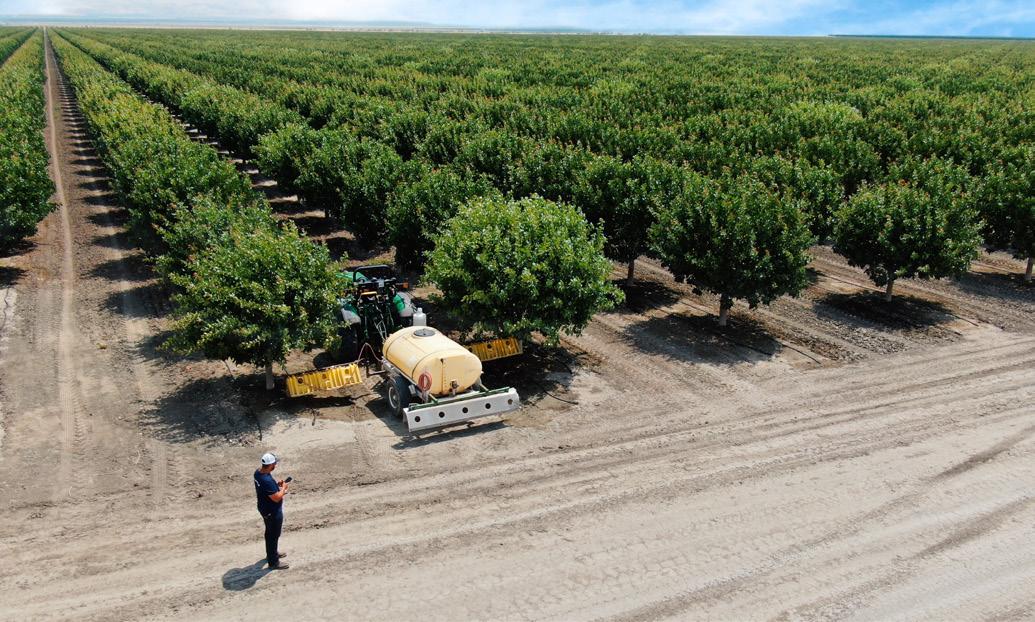 By CECILIA PARSONS | Associate Editor
By CECILIA PARSONS | Associate Editor
It’s not just about ‘more crop per drop.’ Technology trends related to agricultural management presenting opportunities to save on labor and crop inputs, meet regulatory requirements and increase crop quality.
Across the California tree nut industry, farming operations have changed in the past few decades, primarily due to advancements in technology including sensors, machinery and information technology. Robots, temperature and moisture sensors, infrared aerial images and global positioning systems save time and money while producing
higher yields and peace of mind.
Use of new technologies allows precision application of water, fertilizers and pesticides across orchards and fields. Automated systems can direct application amounts in specific parts of fields or orchards. Advantages can include labor savings, higher crop productivity, decreased use of water, fertilizer and pesticides, reduced environmental impact and labor safety. In addition, robotic technologies enable more reliable monitoring and management of natural resources such as air and water quality. Adopting new
technologies also gives growers greater control over production, processing, distribution and storage.
1. Precision Agriculture
Alireza Pourreza, UCCE researcher in biological and agricultural engineering, said use of precision agriculture tools can provide real-time data on soil moisture levels, nutrient content and pest infestations in the context of nut production. This information helps growers and farm managers make informed decisions regarding irrigation, fertilization and pest control, leading
TOP
46 West Coast Nut September 2023
Use of new technologies allows precision application of water, fertilizers and pesticides across orchards and fields (photo courtesy BlueWhite.)
to improved crop yields and resource efficiency.

Pourreza said one crucial aspect is the precise application of nutrients and irrigation, which improves yields and protects the environment’s quality while minimizing waste. Precision agriculture benefits the environment and enhances the nut industry’s profitability and sustainability by optimizing resource utilization and minimizing environmental impact. He noted growers can reduce costs associated with excessive fertilizer and water use, minimize chemical inputs and optimize the health and productivity of their nut trees.
Remote sensing technologies, he added, such as spectral imaging and LiDAR (Light Detection and Ranging), enable the detailed assessment of crop health and productivity from a distance. These technologies can
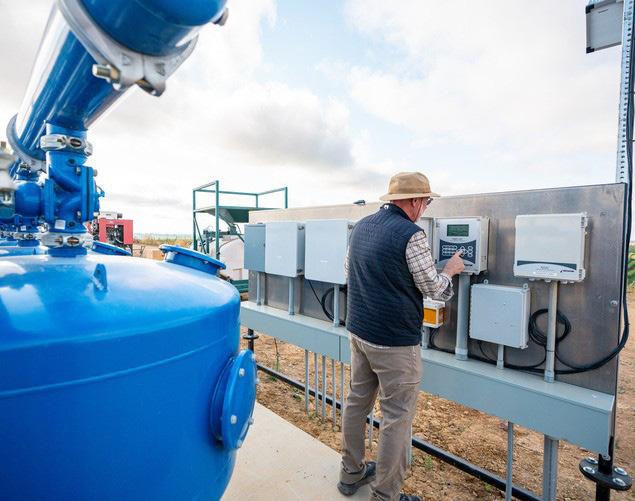
DWNTREES.COM | 1-844-DWN-TREES | @davewilsonnursery FARMER PROVEN SINCE 1938 POTTED AND BARE ROOT TREES AVAILABLE NOW Viking • Atlas • Rootpac R ™ • Hansen • Nemaguard • Lovell HOME OF THE INDUSTRY-LEADING INDEPENDENCE ™ INTRODUCING THE NEW SELF-FERTILE LIBERTY ™ ALMOND Blooms 4-5 Days after Nonpareil • Harvests 10-14 days after Nonpareil ContinuedonPage48
September 2023 www.wcngg.com 47
Integrating automation into an irrigation system is perceived as expensive, but when you factor in the costs of labor and the benefits of saving water and pumping costs, there are cost savings, according to Almond Board of California’s Tom Devol.
ContinuedfromPage47
detect early signs of nutrient deficiencies, disease outbreaks, or water stress in nut orchards. Farmers can proactively address these issues before they significantly impact crop yield, resulting
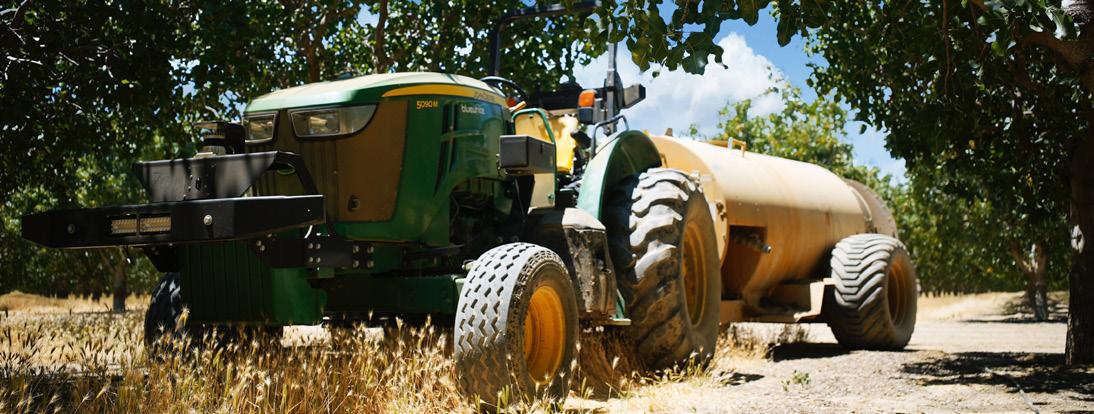

in higher-quality nuts and increased profitability.
Water Management and Irrigation
Tom Devol, senior manager of field outreach and education at Almond Board of California, said huge strides
have been made in irrigation technology in terms of when to irrigate and for how long. Adoption of automation, Devol stressed, will push water management to the next level. Irrigation systems that need to be manually turned off and on lose the exactness of
48 West Coast Nut September 2023
Control over orchard operations, replacing field workers with technicians and securing better information for improved decision making are realities with advances in robotics (photo courtesy BlueWhite.)
water application prescribed by estimates of ET, soil moisture sensors or multispectral imagery.
“We need to embrace automation. Do we have the ability to do this?” Devol asked. Integrating automation into an irrigation system is perceived as expensive, he said, but when you factor in the costs of labor and the benefits of saving water and pumping costs, there are cost savings.
There is also the perception that automation is complicated. This technology may not fit in all operations, Devol said, but many growers have tried it and found it works for them.
Devol said irrigating to crops’ needs is important, and an automated system can achieve that goal if vendors and growers work together and irrigators are trained in system operation.
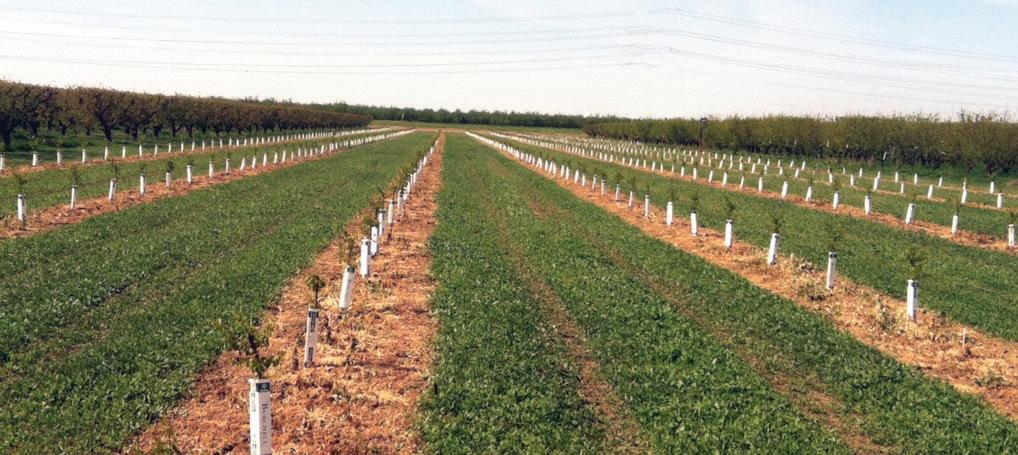
3. Genetic Advances and Disease Management
Almond Board of California and other commodity groups are funding research into genomics assisted breeding. This technology can streamline the process of developing new plant varieties and rootstocks meant to deal with pest and disease management or environmental factors.
Josette Lewis, chief scientific officer at ABC, said molecular markers are being used in breeding programs to increase the selection process. Marker assisted breeding can reduce the time it takes to select for desired traits. In the 2022 ABC Research Update, UC Davis researcher Gina Sidell noted that Exhome sequencing is one molecular breeding tool used to identify variants in a population, particularly traits that are significant but less common. These tools can be combined to make genomic predictions, forecasting phenotypes from breeding crosses based on marker effects, genetic relationship and performance for a trait.
Lewis explained that molecular markers in plant DNA are linked to specific plant traits in varieties and rootstocks. An example is the molecular marker associated with shell closure in almonds as less closed shell promotes navel orangeworm access. The value in speeding up the process of identifying the best crosses is that the
seedlings can be tested to determine if they carry the specific marker desired.
Lewis said there has also been investment in gene editing, a technique that makes precision changes in natural occurring genes. That technology is not yet available, and Lewis noted it is not genetic modification. It may also not be allowed in exports to some countries.
Use of molecular markers for breeding resistance to diseases is complicated, Tom Gradziel, UC Davis genet-
icist, said. When breeding for disease resistance, if each variety of the cross is known to have a resistance gene for the targeted disease, that is simple. He said when multiple genes are involved, that is where molecular markers are a valuable tool for selecting genetic material. He said plant breeders’ understanding of how diseases develop and use of
SUPPRESS® Herbicide EC is the first and trusted leader for certified organic weed control. With years of grower-proven efficacy and university trials, SUPPRESS® consistently provides fast and effective broad-spectrum burndown on a wide variety of post-emergent grasses and weeds.
ADVANTAGES

■ Excellent tool in IPM programs


■ Helps break chemical resistance
■ No pre-harvest interval or MRLs
■ Low-foaming and easy-to-use
■ Highly effective pre-harvest desiccant
(760) 599-8855 • www.san-agrow.com
YOUR YEAR-ROUND ORGANIC SOLUTION FOR WEED CONTROL & DESICCATION Contact us today to learn more. ContinuedonPage50 September 2023 www.wcngg.com 49
combinations of genetic material will be the future for disease control.
4. Data Analytics and Decision Support Systems
Great decision support systems should provide informing data and analytics that predominantly support communication between extension, advisors and producers by providing a shared understanding of what is happening at an industry, regional or farm level, according to Jordan Hazell, research manager at Semios. These support systems can take the form of a platform, offering field-level instrumentation, providing a set of data that help growers and advisors form a shared context and understanding around which they are basing their field-level decisions. These types of systems are particularly valuable, Hazell said, as they enable producers and advisors to gain access to regional disease and pest
forecasting by functioning as a community. An example of this would be regional navel orangeworm pressure reports that summarize regional trapping data which advisors and producers can use to achieve more effective and efficient management plans.
These systems can also help applicators adhere to climate-based regulations and restrictions and stay compliant in an economically efficient manner. Hazell said an example is how a decision support systems can provide weather forecasts that are important when following label guidelines and minimizing risks to the crop. Ultimately this data can support applicators to more effectively plan and minimize downtime during busy production periods.
Hazell said these systems also allow for a greater return of development funding invested into research solutions for key agriculture issues.
5.
Robotics
and Automation
Control over orchard operations, replacing field workers with technicians and securing better information for improved decision making are realities with advances in robotics.
Luke Hemphill, director of partnerships with Fresno-based Bluewhite, said the value of robotic systems is in precision. Autonomous tractors and spray rigs do exactly what the system’s algorithm tells it to do based on planning. Adding a layer of camera, navigation and LIDAR, a series of lasers that create a clear picture of the operating zone, provides the remote operator with all the information needed to oversee the orchard task. The camera and LIDAR are also programmed to recognize specific shapes and to take necessary actions if those objects are in proximity or in its path of operations.
Pesticide and herbicide applications, mowing and other sanitation work can all be carried out by one operator and multiple machines operated remotely. Hemphill said the system developed by BlueWhite can be installed on existing tractors.
The farm implements operated remotely do not just carry out a task; they also provide feedback and data to help the grower make decisions in the future. “They can report excessive vibration or issues with nozzles on a sprayer before a human operator will know it,” Hemphill said.
Grower interest in robotic technology starts with a conversation about not being able to find enough drivers, Hemphill said. But it goes beyond that to confidence that what needs to be done today in the orchard will happen without the element of human error.
“This technology gives growers control and visibility into daily operations. It helps build resilience on farms, connecting machinery that carries out specific tasks when needed and with predictable accuracy.
“All this helps growers make better decisions,” Hemphill said.
Comments about this article? We want to hear from you. Feel free to email us at article@jcsmarketinginc.com
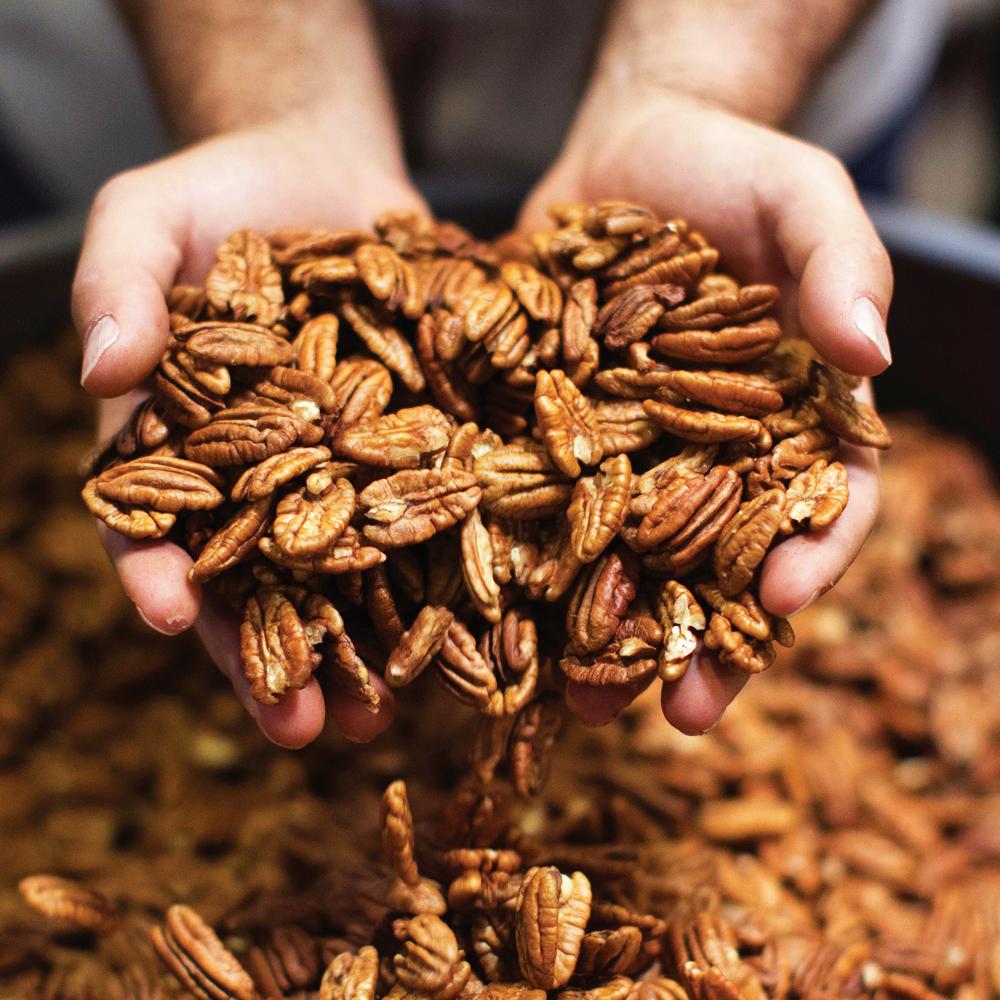
ContinuedfromPage49
50 West Coast Nut September 2023


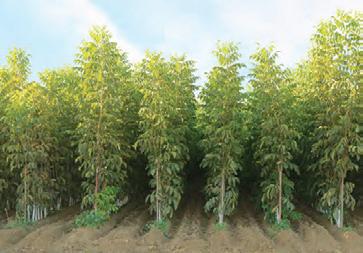



















































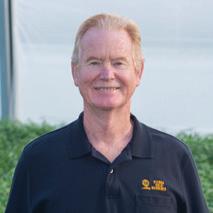
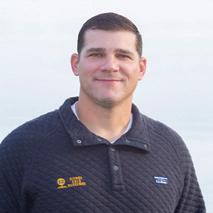
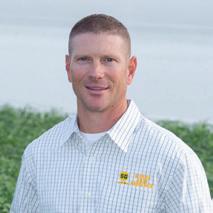












Sierra Gold Nurseries • (530) 674-1145 • sgtrees.com BEST CLONAL HYBRID ROOTSTOCKS PISTACHIOS WALNUTS ALMONDS CONTACT YOUR LOCAL FIELD REPRESENTATIVE PAUL SMITH Butte, Glenn, Tehama & Shasta (530) 517-9338 paul@sgtrees.com BOB FURMIDGE Yuba, Sutter, Colusa, Yolo, Solano, Sacramento & Placer (530) 755-7139 • bob@sgtrees.com RANDY FASANI San Joaquin, Stanislaus, Merced & Madera | (209) 988-7333 randy@sgtrees.com JOSH BERGMAN Fresno, Kings, Tulare & Kern (559) 260-6551 josh@sgtrees.com MATTHEW “BUBBA” HADDON Fresno, Kings, Tulare & Kern (661) 747-3967 • matthew@sgtrees.com Almonds · Walnuts · Pistachios EXPERIENCED ONSITE FIELD SERVICE TO HELP YOU AT EVERY STEP
BE ON ALERT: WILDFIRE SMOKE PROTECTIONS
 By THERESA KIEHN | President/CEO, AgSafe
By THERESA KIEHN | President/CEO, AgSafe
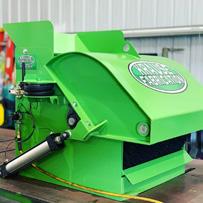
While California had a record rainfall this year, it does not allow us to let down our guard when it comes to wildfire smoke protection. In fact, did you know that in California through July 2023, there have already been 3,880 wildfires, and 95,948 acres have burned? The additional precipitation this season created an abundance of vegetation which is drying out in the late summer months, creating lots of fuel for fires to consume. Coupled with the El Niño tropical weather pattern we are currently experiencing (which can lead to more lightning and thunderstorm activity), this creates the perfect conditions to ignite wildfire activity.
In 2021, the California Department of Industrial Relations’ Occupational Safety and Standards Board (OSHA) adopted a safety standard to protect outdoor workers from the impacts of wildfire smoke. This regulation applies to outdoor worksites where the current Air Quality Index (AQI) for airborne particulate matter (PM) is 151 or higher and where employers should reasonably anticipate that employees could be exposed to wildfire smoke. In this article, I will provide an overview of the regulation and provide some best practic-
Have A Plan and Reduce Exposure

As with many of the other Cal/OSHA regulations, the Wildfire Smoke Prevention Standard requires employers to develop an emergency action plan. This plan must include emergency evacuation routes for all work locations, and the plan should be communicated to your employees. It is also important to have alternate plans in place. If it is suspected the air quality will reach the unhealthy range, consider adjusting the crew’s work schedule, move to another worksite where the air quality is better or to an indoor worksite. A best practice would include contacting emergency services in your area. Discuss your plan details with emergency personnel, provide worksite locations and your communication plan, and ask for their input on proposed evacuation routes prior to an incident occurring.
Monitor Air Quality


It is essential that the person responsible for your crews working outdoors checks the AQI PM 2.5 forecast prior to the shift beginning and throughout the workday. The AQI measures the level of pollution in the air. The index ranges between 0 to 500. An AQI between 0 to 50 is good, 51 to 100 is moderate, 101 to 150 is unhealthy for sensitive groups and 151 to 200 is unhealthy.
The PM measurement accounts for solid particles and liquid droplets in the air. PM 2.5 consists of fine inhalable particles, with diameters that are generally 2.5 micrometers and smaller. A measurement of 2.5 micrometers is about 30 times smaller than the diameter of a human hair. While incredibly small, these particulates can cause damage to our hearts and lungs. The AQI measures the PM 2.5 in the air. For instance, if the AQI is at 30, then the levels of PM 2.5 are in the healthy range; however, if the AQI is 201 or more, the PM 2.5 has reached dangerous levels for people working outside.
Information on the AQI and PM 2.5 specific to your area can easily be found on several websites, including U.S. EPA
209-754-9636 3474 Toyon Circle, Suite 333 Valley Springs, CA 95252 Complete Walnut and Pecan Hulling And Drying Systems 52 West Coast Nut September 2023
AirNow, U.S. Forest Service, California Air Resources Board and your local air pollution district. It is also important to note the AQI and PM 2.5 levels will fluctuate throughout the day, usually getting worse in the afternoon hours, therefore it is critical that the person responsible for the implementation of this plan checks the levels on a regular basis.
Have Respirators Ready
The Wildfire Smoke Prevention Regulation requires employers to provide respiratory protection equipment that filters out fine particles. Respirators must be labeled N-95, N-99, N-100, R-95, P-95, P-99 or P-100, and be approved by the U.S. National Institute for Occupational Safety and Health. If the AQI is 151 or higher but does not exceed 500, respirators must be made available to employees for voluntary use. If the AQI is 500 or greater, respirators are required to be worn. As a best practice, ensure you have an ample supply of respirators in your inventory for your employees throughout the season.
Train Employees

One of the most essential elements of your Wildfire Smoke Protection Plan includes training your employees. The
regulation requires the following topics to be covered in your training program:
• The health effects of wildfire smoke
• The right to obtain medical treatment without fear of reprisal
• How employees can obtain the current AQI (provide them with the website)
• Share your two-way communication system with workers on how you will keep them updated on changing conditions
Provide compliant respirators, show them how to use and maintain them, and encourage them to use them (they can refuse to wear one, and if someone does, there needs to be a waiver where they sign off that they were offered a respirator and declined to use it) The employer must require employees to use respirators when the AQI for PM2.5 is greater than 500.
The importance, limitations and benefits of using a respirator when exposed to wildfire smoke

What you will do to protect them from smoke, when you will stop work, when you will move them to another location, etc.
It is highly recommended that all businesses with an outdoor workforce review the Cal/OSHA regulation, which can be found at dir.ca.gov/ title8/5141_1.html. For additional assistance on developing your Wildfire Smoke Protection Plan or worker training, please contact AgSafe at safeinfo@ agsafe.org.
AgSafe is a 501c3 nonprofit providing training, education, outreach and tools in the areas of safety, labor relations, pesticide compliance and human resources for the agricultural community. Since 1991, AgSafe has educated over 100,000 employers, supervisors and workers about these critical issues.
Comments about this article? We want to hear from you. Feel free to email us at article@jcsmarketinginc.com
September 2023 www.wcngg.com 53
When providing voluntary use respirators, you must train employees on how to wear and maintain them (photo courtesy AgSafe.)
AMERICAN PISTACHIO GROWERS MEETING HIGHLIGHTS MARKETING STRATEGIES FOR GROWERS AND PROCESSORS
By CECILIA PARSONS | Associate Editor
This organization was built to sell your product,” American Pistachio Growers President Richard Matoian told pistachio growers assembled for the annual summer membership meeting.

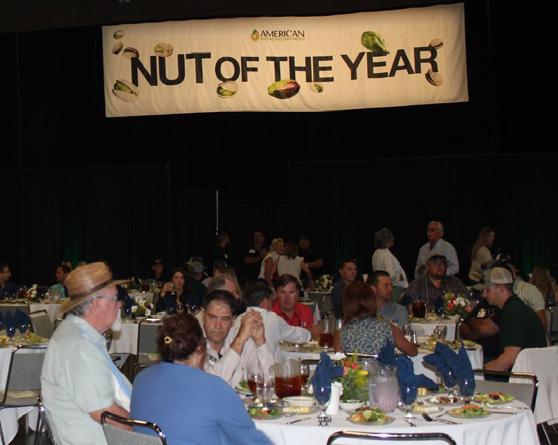
Positive shipment numbers, a focus on sustainability in pistachio production and nutrition-based marketing efforts were highlighted by Matoian along with Haiying Zhang, director of global marketing, APG board member Rich Kreps and APG chair Dennis Woods. Matoian also highlighted some 2022 APG achievements. The organization sought and received purchase of 11.97 million pounds of pistachios for USDA food programs. It lobbied Congress for funding the Navel Orangeworm Sterile Fly release program. The organization’s annual conference, he said, had the highest attendance on record for the pistachio industry.
American Pistachio Growers marketing team is working to build consumer demand ahead of production. APG’s LeadOn program to grow and educate future leaders in the pistachio industry has been renewed, and graduates will be recognized at the annual convention.
Matoian told pistachio growers and processors that all indications point to a large pistachio crop in 2023, outpacing the 2020 and 2021 crops which were the largest in the history of California pistachio production. APG’s
2022 annual report showed expected growth as 2021 and 2022 plantings were each close to 35,000 acres.
Matoian also lauded the APG global marketing team for increasing the number of global markets for U.S. pistachios, noting the pistachio industry has the potential to end the year with the highest number of shipments on record.
Shipments of pistachio nuts to export are up 8.5% compared to last year, he said, although domestic shipments are lower. For the crop year 2022-23, shipments to Asian markets are up 22.2%, shipments to China/Hong Kong are up 7.7% and shipments to India are up 144%. Shipments to the Middle East are up 55.5%. Canadian and Mexican
ContinuedonPage56
“
Pistachio grower and processor members of American Pistachio Growers gathered in Visalia, Calif. for the annual summer membership meeting (photos by C. Parsons.)
Richard Matoian, American Pistachio Growers president, outlined growth of export markets for U.S. pistachios.
" 54 West Coast Nut September 2023
For the crop year 2022-23, shipments to Asian markets are up 22.2%, shipments to China/Hong Kongare up 7.7% and shipments to India are up 144%. Shipments to the Middle East are up 55.5%.
Monitoring is Key to Hull Split Spray Timing
Hull split spray timing is critical in preventing navel orangeworm damage in almonds. To get the timing right, the rst step is monitoring the crop to detect the beginning of hull split.
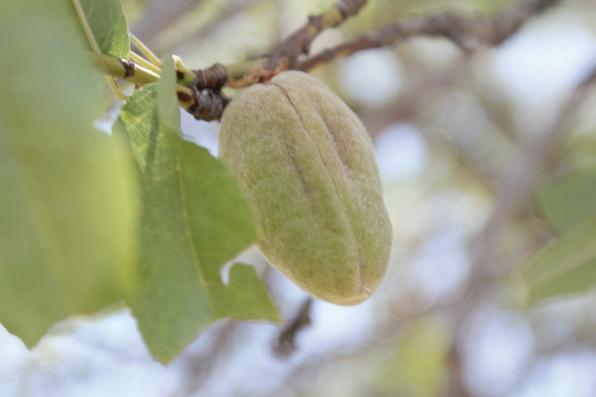
Phosphorus Trial Showed Improved Tree Growth in Young Almond Orchards

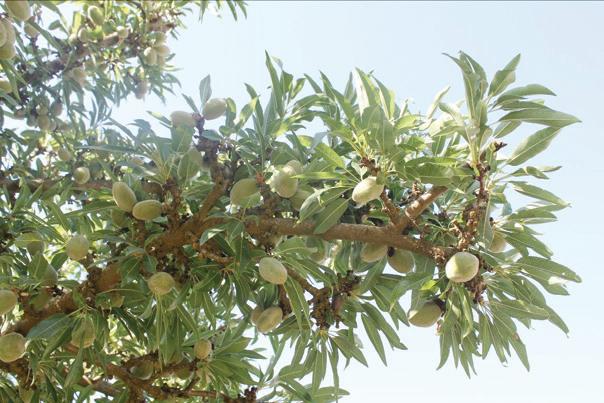
The macronutrient phosphorus is not often at the table when fertilization plans for new almond orchards are discussed. De ciencies of this nutrient are rarely seen in mature orchards, but research done by UCCE Farm Advisor Phoebe Gordon and USDA researcher Greg Browne found positive impacts from phosphorus applications in replant almond orchard eld trials.
Calculating When to Start Irrigation Can Save Money
Following a much wetter winter than normal, soil moisture in many tree nut growing regions of the state is adequate for seasonal tree growth. If you are thinking it is time to initiate irrigation, Tom Devol, Almond Board of California’s senior manager of eld outreach and education, said to rst check your soil moisture.
TOP ARTICLES FROM PREVIOUS ISSUES IN CASE YOU MISSED IT To subscribe scan the QR code or visit myaglife.com/subscribe Don’t miss a single article Subscribe Today receive them directly to your inbox Exclusive Articles Twice a Month
markets as well as European markets showed a drop in shipments.

Focus on Sustainability and Nutrition
“Sustainability will be a driving force in the future,” Matoian said, “and we want to be the ones to define what that means.”
Consumers and buyers increasingly want to know what sustainable practices are being followed by growers, he said. APG has formed an ad hoc sustainability committee and the pistachio industry wants to define how it can be more sustainable to ensure marketability of pistachios. One of their goals is to establish credibility by collaborating with universities and institutions on studies and projects. Initial topics of discussion include improving soil health, cover crops, pesticide MRLs,
groundwater recharge and demonstration projects. Matoian said APG would be applying for grant money to fund the demonstration projects. The next step would be to identify potential orchard sites for the demonstration projects. The ad hoc committee members are Chairman Karun Samran, Joe Coelho, Bob Engleman, Kreps, Rudy Placencia, Gary Smith, Mike Smith and Justin Wylie.
Outlined by Zhang, the APG Marketing Communications Process involves nutrition research, announcement of positive research findings, education with public relations and advertising and health professional outreach. Zhang said these efforts are aimed at changing consumer beliefs and increasing consumer awareness of pistachio health benefits.
APG nutrition research is the foundation for all marketing communication. Funding has led to 77 published studies on health benefits of eating

ContinuedfromPage54
56 West Coast Nut September 2023
Haiying Zhang, director of Asian markets for APG, discusses the public relations campaigns with ambassadors at the annual APG summer membership meeting.
pistachio nuts. American Pistachio Growers is highlighting health benefits of eating pistachio nuts and targeting nine major global markets. A study conducted by Cornell University and funded by APG shows pistachio nuts have a very high antioxidant capacity, rivaling blueberries, cherries and pomegranates.
Nutritionists recommend antioxidants from food sources to help protect healthy cells from free radical damage in the body.



Zhang said other studies have confirmed pistachios are one of the few plant-based foods that are also a complete protein. Pistachio nuts contain all nine essential amino acids in adequate amounts and are considered a complete protein for adults.
A new study published in the journal Applied Sciences found that pistachio extract is effective at inhibiting listeria bacteria in a laboratory setting. Researchers of the study believe the combination of antioxidants and polyphenols in pistachios may contribute to the antimicrobial effect of pistachios.
Amber Wells, director of APG Nutrition Research and Communications, said the results of these studies are being communicated to health professionals.
“This is an important audience as they recommend pistachio consumption to consumers,” Wells said.
There are antioxidant promotions in all pistachio importing countries, and each has customized plant including

public relations with ambassadors, print advertising, digital and health professional outreach.
The effectiveness of all promotions is also measured. Zhang said global results from September 2022 to May 2023 showed 11 million impressions and 3,856 placements with a media value of $214 million. Key messages in all outreach include health benefits, complete protein, weight management
and post-workout recovery.
From a grower perspective, Kreps said the health benefits research is driving demand for pistachios. “More consumers believe the message from health care professionals, and we need to keep funding that research,” he said.
Comments about this article? We want to hear from you. Feel free to email us at article@jcsmarketinginc.com
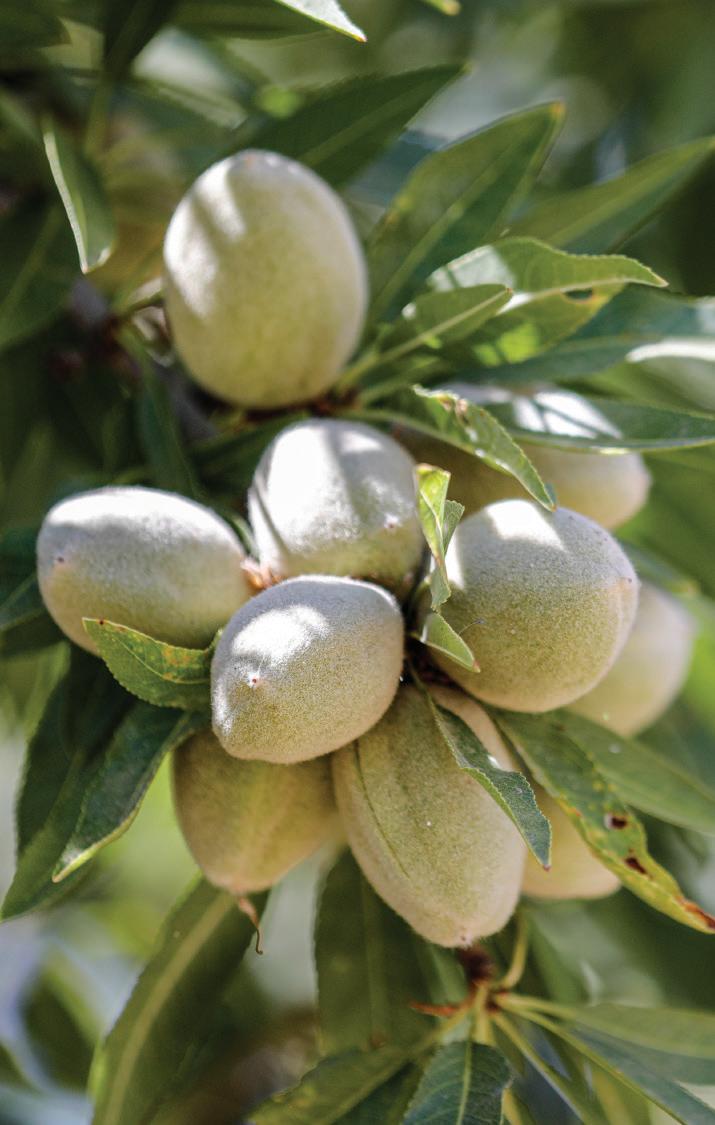
Sustainability will be a driving force in the future, and we want to be the ones to define what that means.” – Richard Matoian, American Pistachio Growers September 2023 www.wcngg.com 57
"
Farm Advisor Profile: Becky Wheeler-Dykes Serving Growers is a Passion for New UC Farm Advisor
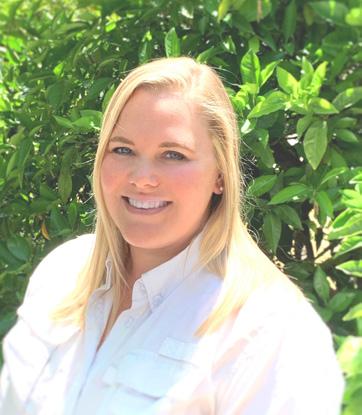
 By KRISTIN PLATTS | Contributing Writer
By KRISTIN PLATTS | Contributing Writer
Becky Wheeler-Dykes chose the wrong major. She started out pursuing civil engineering at UC Davis but knew quickly it wasn’t for her. After convincing her parents she’d be happier in a new area of study, she found herself majoring in crop science and business management and minoring in ag pest management. It was the beginning of a journey that would eventually lead her to UCCE, where she began serving as the orchard systems and weed ecology farm advisor for Glenn, Tehama and Colusa counties this past May.
Growing up on a small walnut and prune farm in Gridley, Calif., the new farm advisor had some specific ag related interests. As kids do, she often explored those curiosities as a child. In her case, she imagined she was a plant breeder, pretending to cross fruit trees in her family’s orchard.
“I was always out catching insects and frogs and playing in the orchard, so I probably should have known that this is where my path would bring me,” Wheeler-Dykes said.
Having never been involved in programs like 4-H or FFA, she said that was where her ag experience more or less ended before college. But she would find her way back to ag once she recognized her academic blunder.
“I realized I don’t really like buildings, I don’t really like being inside
and doing that stuff, so I pretty quickly changed my major,” she said.
In those early days, Wheeler-Dykes started doing research with the Walker Lab at the UC Davis Department of Viticulture and Enology. The venture gave her a taste of the passion she was craving to find in the industry.
“I just really loved that feeling of the moment where you discover something that’s really potentially impactful, and you know that you’re really helping growers,” she said. “You’re not just doing research for the sake of research; you’re doing research that’s actually going to have an effect and really positively impact people.”
Wheeler-Dykes said she especially understands how meaningful that kind of work, the same work she’s doing now with UCCE, can be.
“I really, highly value this work, so it made sense for me to end up here,” she said.
Discovering what career paths she was interested in during her college career was like putting puzzle pieces together, she explained. Once she recognized that she liked to be outdoors, conducting applied research and talking to growers one on one, she knew she was heading in the right direction.
“I like seeing the effects of my work and seeing how it’s actually helping the industry,” she said. “I didn’t really
understand that there was this role, this career that brought all of those things together.”
After receiving her bachelor’s degree, she remained at UC Davis where she earned a master’s degree in entomology. Once she had children, Wheeler-Dykes moved up north to be closer to family. There, she landed at Sierra Gold Nurseries as a lab manager, working on their tissue culture program, before then heading to California State University, Chico, where she lectured in
Becky Wheeler-Dykes began serving as the UCCE orchard systems and weed ecology farm advisor for Glenn, Tehama and Colusa counties this past May (all photos courtesy B. Wheeler-Dykes.)
58 West Coast Nut September 2023
Wheeler-Dykes recognizes challenges looming on the horizon for tree nut growers include California regulations and increasingly intricate world markets.
soil science and ag ecology and contributed to research on mechanical hedging on prunes and olives in Tehama and Glenn counties.
Her position at Chico State was one that helped her transition seamlessly into her current one, she says.
“I was working with all the farm advisors and several of the growers up here,” she said, “so I already knew the team really well, and it just felt like a really nice, easy transition to this position. It’s been really helpful.”
Wheeler-Dykes credits many UC farm advisors, too numerous to name, with inspiring her along the way.
“I saw this world where there were highly respected scientists who were doing research on the ground, who were interfacing with growers, who were a really integral and important part of agriculture. That was really incredible to me,” she said.
Ready to Serve the Growers

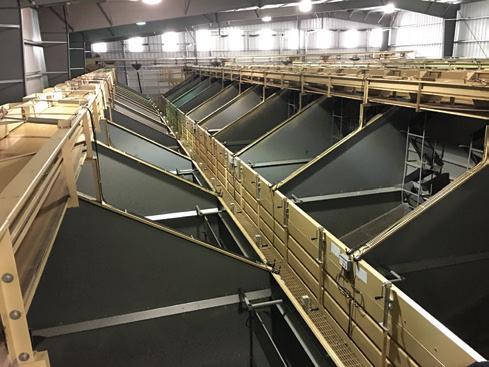
Wheeler-Dykes, who will be based out of the Glenn County office, said the UCCE team, growers and producers in the area have been incredibly welcoming to her so far.
“It feels like a really good fit,” she said.
While there were a number of open farm advisor positions in the north state as she was looking to join UCCE, Wheeler-Dykes said it was the orchard systems and weed ecology advisor that seemed like the right fit, since orchards have always been her passion.
“I think that’s kind of always the direction I was going into,” she said. “The weed ecology part just kind of ended up fitting with the needs of the region. It’s not necessarily my specific background, but I’m excited to step into that role and expand my expertise.”
Currently, almonds and walnuts make up most tree nut crops in Glenn, Tehama and Colusa counties, with some pecans and a steadily increasing acreage of pistachios, she said.


As she continues getting to know the growers in her area, Wheeler-Dykes recognizes many of the challenges looming on the horizon that she believes will be of concern, including California regulations and increasingly intricate world markets.
“I think those two are really going to be tricky with the number of acres planted, both in California and worldwide, for various crops. It’s always going to be a challenge to keep that in balance,” she said.
Other areas she expects to address as farm advisor in the future include climate concerns and drastic weather years, while concerns she’s heard from growers so far have involved irrigation issues and questions about what to prioritize in lean price years.
To tackle these issues and more Wheeler-Dykes says her approach is to work with her fellow researchers while continuing to see what questions come up from growers so she can take her cues from them.
“I think most of the really important research the farm advisors and other ag researchers do, we get the inspiration from the needs of the growers,” she said.
Wheeler-Dykes is Filling a Void

The need for someone to step into the role of orchard systems and weed ecology farm advisor in the three counties has been greatly needed the last few years, according to Franz Niederholzer, an orchard systems farm advisor in Colusa, Sutter and Yuba counties.
The position has been vacant since the fall of 2019, and Niederholzer said the need for a weed specialist is especially great as growers tackle how to deal with a greater number of Roundup-resistant weeds. Weeds like fleabane and bluegrass are of the greatest concern due to their resistance, Niederholzer explained, adding he’s sure there will be an even greater number of resistant varieties to come for Wheeler-Dykes to address with growers.
“There’s a need for weed management knowledge, and certainly in orchard crops, there’s a real need,” he said.
Niederholzer is already quite familiar with Wheeler-Dykes, having been one of the UC advisors she worked with during her time at Chico State, he said.
“She’s a great addition to the farm advisor group,” he said. “UC extension is really fortunate to have some great, young advisors come on in the last five or six years.”
WALNUTS & ALMONDS WALNUT AND ALMOND PROCESSING EQUIPMENT Contact Us Today 3200 TU LLY ROAD, H UG H SON, CA • G ro ssi fa b r i ca ti on.co m 20 9.8 83.28 17 Serving the California Walnut & Almond Industry for over 25 years. Custom Sizing to Fit Your Needs CONTACT US TODAY TO GET A QUOTE FOR THE BEST PRICES • Receiving • Precleaning • Hulling • Drying • In-Shell • Shelling • Eletronic Sorting • Hand Sorting • Packaging Receiving • Precleaning • Hulling • In-Shell • Shelling • Almond Drying • Eletronic Sorting • Hand Sorting • Packaging • Walnut Equipment Almond Equipment Comments about this article? We want to hear from you. Feel free to email us at article@jcsmarketinginc.com September 2023 www.wcngg.com 59
POWERFUL COALITION KEEPS RADICAL WATER RIGHTS
IN THE LEGISLATURE CHANGES FROM ADVANCING
By MIKE WADE | Executive Director, California Farm Water Coalition

When the California Legislative session began last January, farmers were facing formidable efforts to upend our system of water rights. Four different pieces of legislation took direct aim at the stability that water rights provide to farms, cities, businesses, rural communities and the environment. Each entity must make plans based on how much water will be made available to them, and it’s our system of water rights that makes planning possible.
Taken together, this legislation would have handed wide-ranging powers to the State Water Resources Control Board, stripping away many of the checks and balances on the system and undermining due process for water rights holders. These bills would have empowered the Board to adopt sweeping and permanent regulations, not just emergency orders, and put the burden of proof on water rights holders to defend their existing claims.
Given the makeup of the California legislature, with nearly a third of the legislators in their first term, the possibility of stopping these changes seemed challenging at best as the session began. However, a formidable coalition, including agriculture, public water agencies, the business community, and labor organizations, came together and succeeded in stopping, or significantly modifying, these serious threats.
At the time this article is being published, two of these bills have been amended to address the concerns of many, though not all, legal and policy experts in the coalition, and both may see further amendments when the legislature returns in mid-August. The
other two pieces of legislation failed to get out of committee and are now considered two-year bills which will be worked on again next year.
Summaries of Legislation
Assembly Bill 460
While the bill’s stated intent was to make it easier for the State Water Board to discourage, and stop, illegal water diversions, it went much further than needed. The powers granted the Board would have allowed it, or interested third parties, to halt water diversions while limiting constitutionally protected rights to judicial review. The State Water Board would have been able to immediately issue an interim relief order before holding a hearing if it made certain findings. According to one opposition letter, AB 460 “would have the State Water Board serve as prosecutor, judge, jury and executioner in deciding whether an interim relief order is warranted.” The bill would have allowed an interim relief order to remain in place for six months, an entire irrigation season, and deprived water rights holders of meaningful and timely judicial or administrative review.
This bill was stopped in committee and will be discussed again next year.
Assembly Bill 1337
This legislation sought to provide a vast expansion of the State Water Board’s curtailment authority, giving it power to curtail diversions of all water users, including riparian and pre-1914 water rights holders, in “all hydrologic conditions.” It would further have allowed the State Water Board to do by regulation what it currently can only do by adjudication. Opponents of the
COALITION PARTNERS: Association of California Water Agencies
California Building Trades Association
California Business Properties Association
California Alliance for Jobs
California Chamber of Commerce
California Manufacturers & Technology Association
California Municipal Utilities Association
Friant Water Authority
Kern County Water Agency
Kings River Conservation District
Northern California Water Association
San Joaquin River Exchange Contractors Water Authority
San Luis & Delta-Mendota Water Authority
Southern California Water Coalition
Valley Ag Water Coalition
60 West Coast Nut September 2023
Legislative changes to water rights could seriously affect the supplies farmers depend on for irrigating millions of acres of farmland.


bill claimed, “AB 1337 proposes no less than to strip every water right holder in California of their state and federal constitutional guarantee of due process.” For the system to be fair, there must be a process for impacted parties to provide evidence and be heard by a neutral arbiter, and AB 1337 would have taken that away.
This bill was stopped in committee and will be discussed again next year.
Senate Bill 389

Flipping our justice system on its head, this bill would assume someone is guilty until proven innocent, instead of the other way around. It would have authorized the State Board to “drag any water rights holder before the Board to defend its claim of right. . . would stack the deck against all right holders forced into these proceedings by providing minimal due process protections and placing the burden of proof on the right holder.” It would have also authorized the State Water Board to conclude water rights have been forfeited even without a conflicting claim as is the case under current law. This would have pushed water users to consume as much water as possible to reduce the risk of forfeiture at the exact time when the State should be encouraging greater conservation.
This bill has been amended to clarify the authorities of the State Water Board, making them consistent with some legal experts’ perception of existing case law. After the legislation was amended, several organizations in the coalition shifted their opposition to a “watch” position. It will be considered by the Assembly Appropriations Committee when the legislature returns in mid-August.
Assembly Bill 676
Claiming to strengthen the directive that the highest use of water in California is for domestic purposes and the next highest use is for irrigation, what it really would have done is add confusion and create litigation risk. By statutorily adopting existing regulations and case law, AB 676 would have opened the door for uncertainty in one of the few areas of water law that is relatively clear.
This bill has been amended to clarify existing regulations in statute and coalition opposition has been removed. It will be considered by the full Senate when the legislature returns in mid-August.
California’s elected officials debated significant changes to the State’s historic system of water rights this year with mixed results. At least two bills were pushed off for more discussion next year.

While much work remains to be done, the achievements this legislative session cannot be understated. At a time when farms and farmers seem to be continuously under attack, this coalition effort presents a bright spot in a sometimes-daunting landscape of challenges.
Comments about this article? We want to hear from you. Feel free to email us at article@jcsmarketinginc.com

September 2023 www.wcngg.com 61
Nail Down Your Macros and Micros Don’t miss out on critical postharvest nutrition this year.
 By RICH KREPS | CCA, SSp., Contributing Writer
By RICH KREPS | CCA, SSp., Contributing Writer
As we wind down almond harvest, ramp up pistachios and roll into walnuts and pecans, the fast and furious comes in like a lion and goes out like a lamb. Although it’ll be a slower pace for a while, you’re not done yet. I’m always harping on postharvest plans and making sure they are in place before it’s too late. I’ve used the analogy in the past of the triathlete. After a long race, like our trees just went through, they never just go home, take a shower and go to bed. They eat. They must

replenish their carbohydrate storage in the muscles for recovery and repair. Our trees act in much the same way. After producing all those delicious nuts we love to eat, we must feed our trees to prepare for winter, repair the harvest damage and store some food. We need them to do it again next year, and do it well, again and again.
Many of my clients used to think of postharvest as something that happens when we amend our soil in November and December. This is not the same as
feeding our trees after harvest. IMMEDIATELY! Many of my clients now feed almonds after the Nonpareils are picked up, even before the pollinators are shaken. At the very least, I beg them to get something on when the last nut leaves the rows. There is typically a major root flush happening when trees are preparing to recover. Pistachios can be done between the first and second shakes. That’s the time to give them a good drink of balanced postharvest nutrition. You want to utilize every bit of growing season we have left. The better those trees recover and store, the better equipped they are to maximize bloom in spring.
Hit ‘Em with Everything
Hit them with a solid shot of nitrogen and calcium for building those fine root hairs. Then follow that up with plant-ready phosphorus, potassium and whatever micros you were short of in your last tissue test. A quart or two of magnesium never hurts during postharvest as chlorophyll is critical to producing carbohydrates for winter storage. Remember, Mg is the central element of chlorophyll. If you ended up short on boron (less than 200 ppm in your tissues), add some now. If you have sodium issues, I recommend a boric acid solution instead of the salt option. Zinc and manganese are important for new growth and seed health. And nuts are the trees seeds. Keep these levels up during postharvest recovery. If it’s been a while since you applied it, or you’ve never applied or tested for it, add a pint of cobalt and molybdenum. Molybdenum is very synergistic with N utilization and great for soil health. Co is the key element in vitamin B, which
62 West Coast Nut September 2023
has been used as a plant food nutrient for decades under the label of the vitamin, not the element. Add a pint per acre.


Logistically, this may seem tough to do with those nutrients that don’t play well together. However, consider shorter sets more often for recovery. You can run several 12-hour sets, separated by a few days and keep adding those different forms of nutrition. None of it has to be applied all in one shot. And if those leaves are still covered in dust from harvest, consider a foliar spray. You can add those micros while cleaning the leaves off at the same time, further enhancing your photosynthesis. This will also allow you to run some calcium downstairs while you spray orthophosphorus upstairs. This enables you to get two nutrients that can’t be mixed in decent concentrations together into a tree at almost the same time.
If you have followed the guidelines of whichever favorite professor you agree with and saved the recommended 25% N amount for postharvest applications, add that in three sets instead of one. Give the trees a better chance to absorb it all. And start early. We lose so much efficacy the longer we wait to apply our postharvest nutrients. As we get closer to leaf abscission, nutrients stop getting assimilated onto the fruit wood and back down into the trunk and roots. We can get a better nutrient load dispersal the earlier we start. Take advantage of that and accumulate higher concentrations throughout the trees. Many of those nutrients should be closer to the blooms when all hell breaks loose next spring.
I know I harp on this every fall in hopes that many will take it to heart.
Nitrogen and phosphorus start high in the spring, and they need a healthy mix of nutrients to carry out all the enzymatic reactions necessary for growth and bloom. Postharvest is way more critical than we previously thought to start those trees out right after winter. Missing this critical step in the health of an orchard can be detrimental. Being late can hurt almost as much. Be diligent, plan now and get it going. Even a small, early shot of a balanced
NPK with some micros will help much more than doing nothing. The earlier you start, the better chance you have of assimilation. Waiting too long or just thinking the soil amendment apps will suffice is probably leaving higher yields out in the cold.
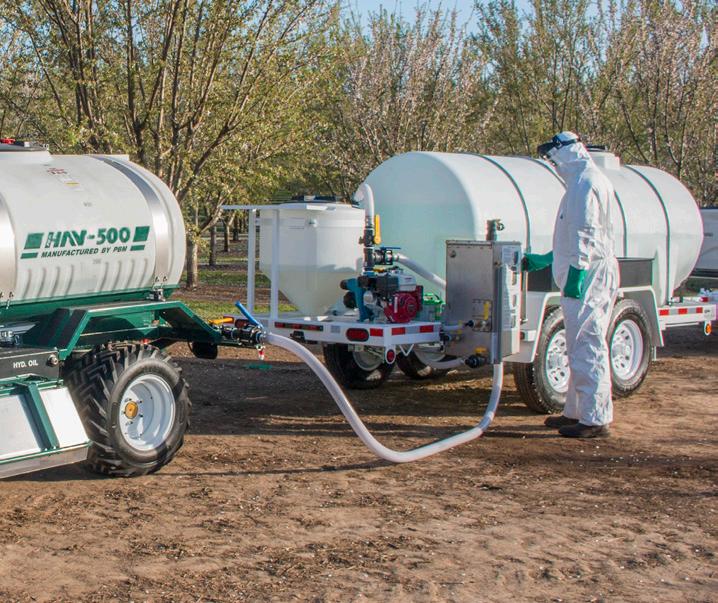
PBM Supply & MFG., INC. Quality Agricultural Spray Equipment, Parts and Supplies www.pbmsprayers.com www.pbmtanksupply.com Since 1969 CLOSED MIXING SYSTEMS PBM’s Tier-1 closed mixing system will drain, triple rinse, and cut chemical containers while they are sealed inside a stainless steel mixing box. Available on PBM’s Batch Mixing Trailers, Mixing Stations, or Sold Individually to adapt to your existing mixing equipment. Chico - 530-345-1334 324 Meyers St. Chico, CA 95928 Yuba City - 530-671-0068 955 N. George Washington Blvd. Yuba City, CA 95993 Fowler - 559-834-6921 3732 S. Golden State Blvd. Fowler, CA 93625 Murrieta - 951-696-5477 41648 Eastman Dr. Murrieta, CA 92562 -Sprayers- -Tanks- -Liquid Delivery Trailers- -Parts & AccessoriesCall 1-800-688-1334 To Find A Dealer Near You! Comments about this article? We want to hear from you. Feel free to email us at article@jcsmarketinginc.com September 2023 www.wcngg.com 63
Power ed by HEXA™
AgroPlantae’ s HEXA™ Technology is an advanced agricultural solution that unites traditional fertilizers with regenerative soil practices.

It consists of two product lines: HEXA TEAM, an NPK range, and HEXA TECH, a micronutrient line, both powered by HEXA™ Technology. These products contain six plant active ingredients and certified Organic Matter (OM), benefiting the soil by enhancing its structure, nutrient availability, water retention, and fostering an environment for thriving soil biology and their numerous associated advantages.
HEXA™ Technology enhances NPK with plant extracts, providing an energy boost that optimizes physiological processes supporting cropland and reducing yield losses due to stress. It also positively impacts crop quality attributes like sugar content, weight, and size.
HEXA TEAM is formulated with highly available forms of nutrients, maximizing crop utilization while minimizing environmental and soil losses. This is achieved through a two fold approach:
1. Using concentrated and readily available nutrient forms.
2. Increasing OM in the rhizosphere and invigorating biology to stimulate soil and maintain nutrients for immediate and future use.
HEXA TECH is a line of soil applied micronutrients featuring natural plant extract chelation, powered by HEXA™. It represents the most effective, biodegradable, and sustainable natural based chelate available. The plant extracts and amino acids act as carriers for micronutrients, ensuring rapid uptake and adding a biostimulant growth action, leading to stronger crops.
Trials conducted in soils (pH 8.2 8.8) compared HEXA TECH Cu, Zn, and Mn to traditional EDTA. HEXA TECH demonstrated higher efficiency and easier absorption than EDTA micronutrients, making it a superior choice for growers.

Visit AGROPLANTAE.COM or give us a call (559) 498 0388 to learn more Advertorial
Figure 1. Micronutrient foliar concentrations of Cu, Mn, and Zn for GS EDTA (gray) and HEXA TECH (yellow).
HEXA TECH vs EDTA Micronutrients






















 By GUIDO VAN DER HOEVEN | Extension Specialist/Senior Lecturer Emeritus, North Carolina State University
By GUIDO VAN DER HOEVEN | Extension Specialist/Senior Lecturer Emeritus, North Carolina State University


































 The pistachio industry is funding research to gain a better understanding of the causal fungal agents and potential management of ochratoxin A (photo by V. Boyd.)
The pistachio industry is funding research to gain a better understanding of the causal fungal agents and potential management of ochratoxin A (photo by V. Boyd.)


















 By LORI FAIRCHILD | Contributing Writer
By LORI FAIRCHILD | Contributing Writer


















 Under Keith Rigg, Minturn Nut has invested heavily in new equipment in recent years to improve quality and throughput.
Most of Minturn Nut’s almonds are exported.
Shipments run year-round from Minturn Nut’s LeGrand facility.
These pallets stacked with 50-pound cartons of brown-skin almonds are headed to Dubai.
Under Keith Rigg, Minturn Nut has invested heavily in new equipment in recent years to improve quality and throughput.
Most of Minturn Nut’s almonds are exported.
Shipments run year-round from Minturn Nut’s LeGrand facility.
These pallets stacked with 50-pound cartons of brown-skin almonds are headed to Dubai.


 Minturn Nut’s Keith Rigg says socially conscious, or ESG, policies are “hollow and phony.”
Minturn Nut’s Keith Rigg says socially conscious, or ESG, policies are “hollow and phony.”





















 To improve production and post-harvest practices, the Walnut Commission and Board will seek to uncover “pain points” among growers and handlers (photo by C. Merlo.)
Moving walnuts beyond the baking aisle and into the produce section is just one goal of the new strategic plan (photo by C. Merlo.)
To improve production and post-harvest practices, the Walnut Commission and Board will seek to uncover “pain points” among growers and handlers (photo by C. Merlo.)
Moving walnuts beyond the baking aisle and into the produce section is just one goal of the new strategic plan (photo by C. Merlo.)













 By KRISTIN PLATTS | Contributing Writer
By KRISTIN PLATTS | Contributing Writer
 Recent USDA research efforts are trying to improve the ability to predict when and where NOW is going to be problematic for walnuts (photo by Patty Grebs, USDA.)
Recent USDA research efforts are trying to improve the ability to predict when and where NOW is going to be problematic for walnuts (photo by Patty Grebs, USDA.)




 By CECILIA PARSONS | Associate Editor
By CECILIA PARSONS | Associate Editor



















































 By THERESA KIEHN | President/CEO, AgSafe
By THERESA KIEHN | President/CEO, AgSafe



















 By KRISTIN PLATTS | Contributing Writer
By KRISTIN PLATTS | Contributing Writer











 By RICH KREPS | CCA, SSp., Contributing Writer
By RICH KREPS | CCA, SSp., Contributing Writer





